Timing is crucial, especially regarding such a significant financial commitment. To help you navigate this maze, this eXp Realty guide will tackle topics such as the factors to consider when buying a home, tips on how to time the real estate market, and more.
Buying a House in Today’s Market
Purchasing a home is not merely about finding the perfect fit in terms of space and design; it’s also about aligning with the broader real estate market conditions. If you understand the nuances in today’s dynamic housing market, you can distinguish between a lucrative investment and a potential pitfall.
The personal situation of most potential home buyers plays a significant role in the decision-making process. With mortgage rates witnessing both spikes and dips, ensuring that your monthly payments remain manageable is essential.

However, apart from your monthly mortgage payment, other factors like property taxes, closing costs, and potential fluctuations in housing prices also weigh in on the decision.
In such cases, a credit score is pivotal in determining the kind of mortgage loan you might qualify for. Borrowers with credit scores on the higher end of the spectrum tend to receive more favorable terms from lenders.
This means they might be eligible for lower mortgage payments and better loan options, further enhancing their buying power in the current market. Additionally, ensuring you manage your credit card bills on time and maintain low credit usage can improve your negotiation power.
The median sale prices of homes have witnessed upward pressure in some regions, while others offer many housing options due to an inventory surge. Potential buyers should explore the housing inventory of various areas before committing to any deal.
Having a skilled eXp real estate agent by your side can be invaluable, especially when navigating the intricacies of housing market conditions. They offer quality service, ensuring potential homebuyers are informed about all factors—from mortgage rates and credit score requirements to the market’s current pace.
Factors To Consider Before Buying a House
Before diving into the world of homeownership, it’s vital to understand the numerous factors at play. From your financial health to the intricacies of the real estate market, making an informed decision can make all the difference. Here’s a breakdown to guide potential homebuyers through the maze.
Financial Stability and Readiness
The journey to homeownership starts with a solid foundation of financial stability.
Your Current Financial Situation
Before taking the plunge, evaluate your savings, investments, and monthly expenses. Remember, purchasing a home isn’t just about the upfront costs; you’ll need to budget for monthly mortgage payments, property taxes, insurance expenses, and potential unforeseen repairs.
Your Credit Score and Debt-To-Income Ratio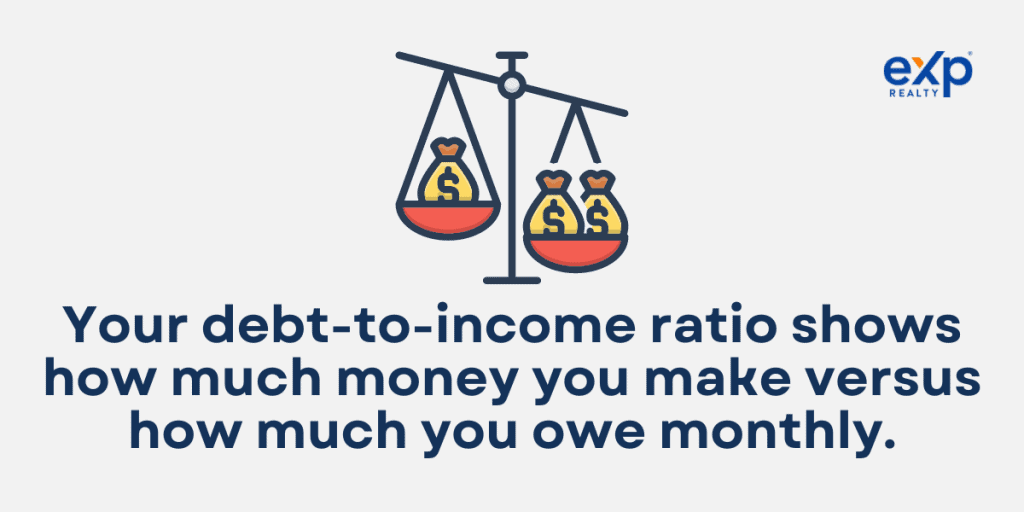
A healthy credit score opens the door to better mortgage rates and terms. Simultaneously, lenders often use the debt-to-income ratio to gauge your ability to manage monthly payments effectively. A lower ratio indicates you’re not drowning in debt and can handle the financial responsibilities of owning a home.
Affordability and Budgeting for Homeownership
Beyond the purchase price of the house, factor in closing costs, homeowners’ association dues, and routine maintenance. Using tools like mortgage calculators can help prospective buyers determine how much home they can afford, considering all these additional costs and come up with a solid home buying budget.
Real Estate Market Analysis
Understanding the real estate landscape is critical to ensuring your investment is sound.
Current Market Trends and Conditions
Dive into the current housing market trends to determine whether it’s a buyer’s or seller’s market. This will give you a sense of your bargaining power and the potential price you might pay.
Supply and Demand Dynamics
A surplus in housing supply usually leads to a drop in house prices, providing a favorable environment for buyers. Conversely, high demand with limited inventory can push prices up.
Price Fluctuations and Market Forecasts
The real estate market is cyclic, with periods of growth followed by stagnation or even decline. Monitoring market forecasts and understanding potential price fluctuations allows you to time your purchase to maximize your investment.
Personal Circumstances and Long-Term Plans
Your personal life and future ambitions are significant in the home-buying decision.
Your Lifestyle and Future Goals
If you envision starting a family soon, you might want more space or proximity to good schools. On the other hand, being closer to urban centers might be more appealing if you’re a young professional.
Job Stability and Potential Relocations
There may be better decisions than committing to buying if there’s uncertainty in your career or the possibility of relocating in the next couple of years.
The Need for Space, Amenities, and Community Factors
Consider your ideal living environment. Do you want a backyard? Is a gym or community pool on your wishlist? Understanding what you want will help narrow down your options.
Other factors to consider include the potential for property appreciation, local property tax rates, and the overall vibe and safety of the neighborhood. Moreover, accessibility to essential amenities like hospitals, supermarkets, and recreational facilities can significantly influence the quality of life in your new home.
Tips on How To Time the Local Real Estate Market
Timing the local real estate market can provide significant advantages to prospective buyers. However, navigating market conditions can be complex. By following these key strategies, potential homebuyers, either first-time buyers or seasoned investors, can make informed decisions and capitalize on opportune moments in the market.
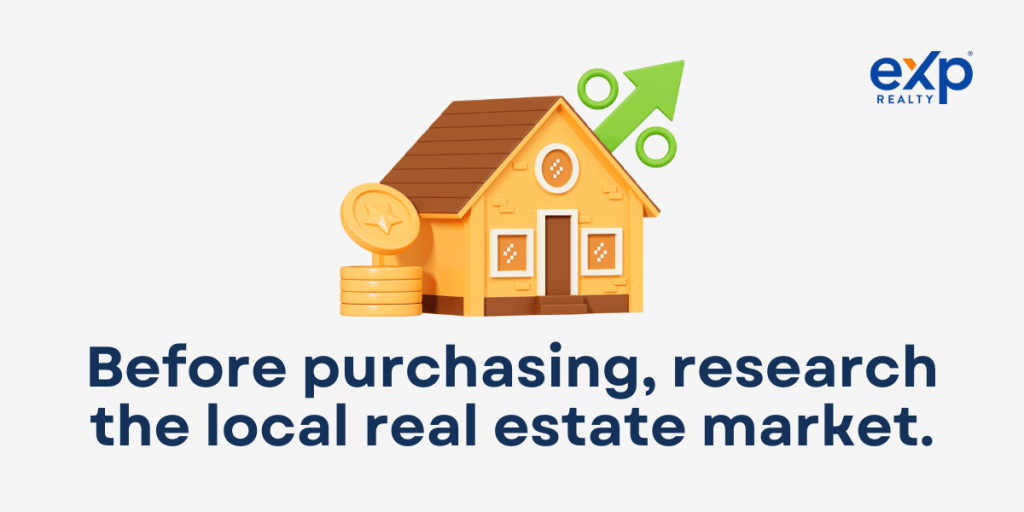
Conduct Market Research
To make a well-informed decision, it’s imperative to have an in-depth understanding of the local real estate landscape.
- Gather data on local home prices and sales trends: By analyzing housing prices and observing the dynamics over a period, you can gauge whether the market is on an upward trend, stabilizing, or declining.
- Examine the average days on the market and bidding wars: Properties quickly snatched up (low days on the market) or that experience intense bidding wars indicate a hot market. On the other hand, homes that linger on listings suggest buyers might have more negotiation power.
- Seek insights from real estate professionals and experts: Connecting with local real estate agents, especially those affiliated with platforms like eXp Realty, can provide invaluable expertise.
Identify Emerging or Declining Neighborhoods
Picking the right neighborhood can significantly impact the appreciation potential of your investment.
- Analyze neighborhood growth potential: Emerging neighborhoods often show signs of development, from new establishments opening up to infrastructure projects underway. Such areas can offer affordable options with high appreciation potential.
- Evaluate infrastructure development and amenities: Future developments, such as a new school, park, or shopping center, can boost a neighborhood’s desirability. Similarly, quality amenities like gyms, parks, and communal spaces can impact housing options and prices.
- Consider future market demand and desirability: Factors like accessibility to work hubs, public transportation, and lifestyle amenities can make a neighborhood more desirable in the long run. Additionally, understanding demographic shifts and major regional subgroups can provide insights into future demand.
Work With Real Estate Professionals
With their vast expertise and in-depth market knowledge, real estate professionals can be invaluable allies in your home-buying journey.
Find a Trusted Real Estate Agent
Leveraging real estate platforms can connect you to local experts who know the intricacies of the regional market, from current housing market trends to the nuances of individual neighborhoods.
Evaluate Their Knowledge of the Local Market
A seasoned agent should be able to guide you through market conditions, from inventory levels to median sale prices. They can also provide insights into market forecasts, giving you information to make an informed decision.
Understand Their Role in Negotiations and Transactions
A real estate agent not only aids in finding potential homes for sale but also plays a crucial role during negotiations. They ensure you’re getting the best deal, considering all the factors, from house prices to potential future developments in the area.
Consult a Mortgage Lender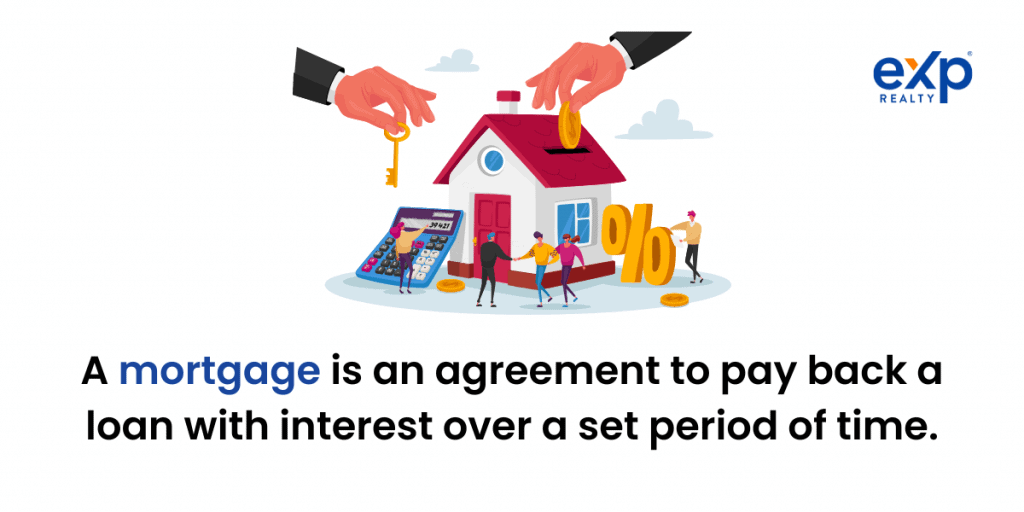
One of the primary steps before venturing into the housing market is understanding your financial position about lenders.
Assess Your Borrowing Capacity and Loan Options
Different mortgage lenders will offer varying terms based on your credit score, income ratio, and overall financial stability. Tools like mortgage calculators can give an idea about potential monthly payments. Furthermore, various mortgage types have pros and cons, such as 30-year fixed-rate or adjustable-rate mortgages.
Obtain Pre-Approval for a Mortgage
A pre-approval is more than an estimate. It’s a commitment from a lender that they will lend you a certain amount under specific terms. This enhances your buying power and signals to sellers that you are a serious buyer.
Understand the Implications of Interest Rates and Loan Terms
The current mortgage interest rates, whether at an all-time low or showing signs of elevation, will directly impact your monthly mortgage payment.
Know Your Risk Tolerance and Timeline
Although real estate may seem a sound investment, it carries risks and opportunities that must be evaluated in line with personal investment strategies.
Assess the Potential for Short-Term and Long-Term Gains
Some neighborhoods or housing options might present quick appreciation due to factors like a sudden jump in inventory or significant infrastructure projects. In contrast, others are better suited for long-term growth.
Evaluate the Stability of the Housing Market
With the potential for economic uncertainty, it’s crucial to gauge if the housing market is experiencing a temporary surge or is poised for consistent growth.
Align Your Decision With Your Investment Goals and Timeline
Your situation, from job stability to life goals, should dictate your timeline in the real estate market. Your approach would vary considerably if you’re looking for a family home or a long-term investment property.
Key Takeaways
Is now a good time to buy a house? In the intricate dance of buying a house, timing is crucial. Here are the pivotal insights from this exploration:
- Understand the current real estate landscape: Whether it’s a buyer’s or a seller’s market, being informed about housing market trends and prices can significantly affect your buying decision.
- Financial preparedness is key: From assessing your credit score to understanding monthly expenses, potential homebuyers must be financially ready.
- Lean on professionals: Real estate agents and mortgage lenders offer invaluable insights.
- Personal considerations matter: Beyond market conditions, personal circumstances, from lifestyle choices to plans, play a pivotal role in the home-buying process.
While “Is now a good time to buy a house?” might seem daunting, it can be addressed with informed decision-making, understanding the real estate market conditions, and seeking expert advice.
Remember, buying a home is not just a financial decision but a significant life choice. Is now the right time for you to buy a home? Sign up to get alerts of new property listings when they come on the market
FAQs: Is Now a Good Time to Buy a House?
Navigating the complex world of real estate often brings forth numerous questions. Below are some of the most frequently asked questions concerning the current state of the housing market:
Is 2023 a good year to buy a house?
Like any other year, 2023 comes with its market conditions and economic indicators. While we’ve delved into various factors above, the decision to buy depends on current housing market trends, your financial situation, and broader economic conditions. It’s always wise to consult real estate professionals for insights tailored to your needs.
What is the best time to buy a house?
The best time to buy a house often depends on market conditions, personal finances, and individual goals. Historically, many believe spring and summer are peak buying seasons due to the influx of homes for sale. However, some find success in purchasing during fall or winter when there’s potentially less competition. Constantly monitor mortgage rates, inventory levels, and local market dynamics.
What time of year are house prices lowest?
House prices are typically somewhat lower during the late fall and winter months. This can be attributed to reduced buyer competition and decreased housing inventory. However, this also means there might be a lower range of homes to choose from.
What month are home prices highest?
Home prices often peak during spring and early summer, particularly between April and July. This is when many families aim to move so that they’re settled before the new school year begins. It’s also when properties generally look their best due to favorable weather.
Is it a good idea to purchase a home when a recession is imminent?
Buying a house before a potential recession can be a double-edged sword. While property prices might be lower and there may be more room for negotiation, economic downturns can lead to job losses and financial instability.
It’s essential to weigh the pros and cons, consider your job security, and evaluate your financial cushion. Consulting with financial advisers and real estate experts can provide a clearer perspective.
]]>Its unique blend of practical design and aesthetic charm makes it a popular choice for many homeowners. Learn more about Cape Cod style houses in this guide, and if you’ve been conserving owning one of these architectural treasures, explore available listings to find the best property for you.
History of Cape Cod Style Houses
The Cape Cod style house originates in the 17th century, influenced by the construction of English cottages. Puritan settlers arriving in New England adapted the English Hall and Parlor house, blending practicality with the region’s harsh weather conditions. Cedar shingles, central chimneys, and steep roofs became defining characteristics of this early American architecture style.
Evolution Through Centuries
Over time, the Cape Cod style has undergone several transformations. The 18th and 19th centuries saw variations in design, including the addition of Greek Revival and Colonial Revival elements. The Mid-20th Century Cape Cod Revival revitalized the style, making it appealing for first-time home buyers and those looking for modest-sized, manageable starter homes.
A Living Tradition
Despite these changes, the Cape Cod style house has maintained its core features, symbolizing traditional American family living. Whether seen in the early colonies or modern times, Cape Cod style homes remain an enduring part of the American architectural landscape.
Key Features of Cape Cod Style Houses
A real estate agent has an eye for identifying Cape Cod style houses, but there are a few things that characterize a Cape Cod style house you can look out for. Let’s explore some of them.
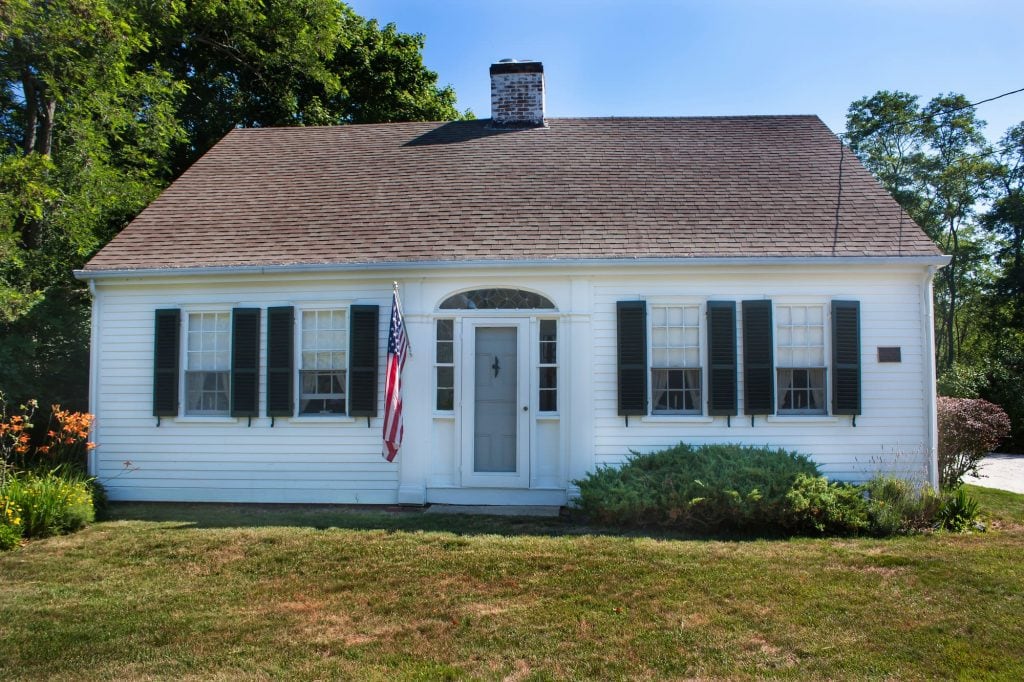
Exterior Characteristics
A Cape Cod style home is known for its rectangular footprint, symmetrical design, and simple, clean lines. The steep roof is not only a distinctive feature but a practical one, allowing snow accumulation to slide off during heavy snow and extreme winter climates.
The exterior often features shingle siding, adding a rustic charm that recalls the early American settlers’ reliance on readily available materials. Decorative shutters, often in classic black or green, frame the multi-paned windows, while centralized massive chimneys hint at the warmth within.
Natural Materials
Along with its roots, Cape Cod architecture utilizes natural materials like cedar shakes and pine shingles. The materials blend seamlessly with the region’s salt air and harsh climate, showing Cape Cod’s connection with its environment.
Iconic Windows and Dormers
Dormer windows are a defining feature of Cape Cod style houses, providing extra bedroom and attic space. Combined with the iconic multi-pane windows, they offer excellent air circulation and fill the common spaces with natural light.
Harsh Winters and Practical Design
A Cape Cod house’s low, broad structure is not just about aesthetics; it’s a practical response to the New England region’s cold winters and harsh weather conditions. The modest size and rectangular floor plans provide a blank canvas for creativity, while the centralized chimney ensures that the living space remains cozy and warm.
The Cape Cod style is a testament to the adaptability and ingenuity of early American architecture, influenced by English cottage homes but distinctly American in its evolution and enduring presence. Whether you’re a fan of historic homes or looking for the charm of cedar shingles and dormer windows, the Cape Cod style house offers a livable space full of character.
Interior Design of Cape Cod Style Houses
Cape Cod style houses emphasize simplicity and functionality in interior design. Reflecting the New England Puritan carpenters’ ideals, the Cape Cod house designs offer clean lines and practical layouts.
Floor plans are often designed to maximize living space without excess, focusing on family-oriented common spaces.
Neutral Color Palette
A serene and timeless atmosphere is created through a neutral color palette within Cape Cod interiors. Light blues, greens, and earthy tones blend harmoniously with natural light, offering a calming effect.
Paired with white trim and muted fabrics, this design evokes Cape Cod’s salty sea breeze and coastal tranquility.
Wood Flooring and Exposed Beams
Hardwood floors and exposed beams are essential elements in the Cape Cod type of house. These features add warmth and character to the living space, complementing natural materials like wicker and rattan. Wood integration creates an inviting, cozy ambiance that resonates with Cape Cod’s regional variants.
Cozy Living Spaces
The interior of a Cape Cod house is synonymous with comfort and invitation. Reclaimed wood, plush furnishings, and simple floor plan designs encourage a relaxed lifestyle. Whether enjoying time in the primary bedroom or the parlor, Cape Cod style interiors are designed for relaxation and family bonding.
Natural Materials and Décor
Wicker, rattan, and reclaimed wood are not merely decorative choices but a testament to Cape Cod’s connection to nature. These materials underline the house’s manageable size and homely appeal, creating a living space that reflects the historical context and modern times’ sustainability focus.
Landscaping and Outdoor Spaces
The exterior of a Cape Cod style house is equally as significant as the interior, with curb appeal playing a vital role in the home’s charm.
Traditional landscaping, often featuring decorative shutters, cedar shakes, and symmetrical greenhouses, is carefully curated to mirror the house’s unique characteristics. Using native plants and stones is common, enhancing the natural connection between the home and its surroundings.
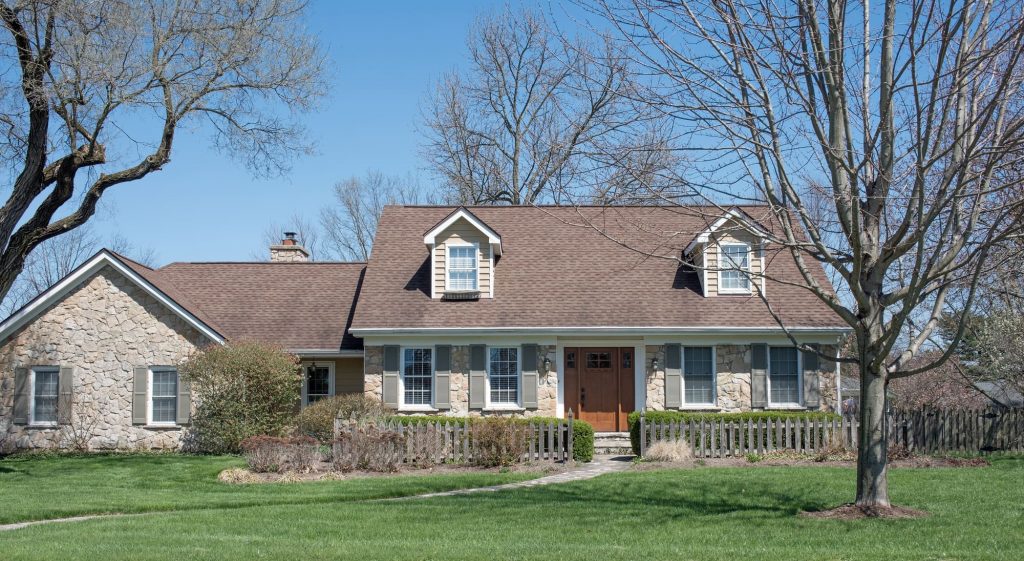
Porches and Decks
Outdoor areas like porches and decks are essential to the Cape Cod lifestyle. These spaces serve as an extension of the home, allowing residents to enjoy the fresh salt air and scenic beauty of coastal living.
Whether used for entertainment or relaxation, these additions enhance the livable space of the Cape Cod house and emphasize its connection with nature and the regional climate.
Cape Cod style houses are not merely a building type or a collection of architectural features. They are a living embodiment of American history, culture, and adaptability. From the steep roof characteristic of the earliest houses to the unique feature of modern cedar shakes, every aspect is infused with purpose and charm.
How to Maintain and Preserve a Cape Cod Style House
Owning a Cape Cod style house is about enjoying its beauty and functionality and properly maintaining and preserving its unique characteristics. Here’s how:
Regular Maintenance and Preservation Efforts
The timeless charm of Cape Cod style houses lies in their pristine condition, achieved through regular maintenance. Whether it’s the pine shingles, master suite features, or exterior characteristics, a systematic approach to upkeep ensures that the house remains visually appealing and structurally sound.
Preserving Exterior Elements
The cedar shingles, decorative shutters, green shutters, and black shutters that adorn Cape Cod homes require specific attention:
- Shingle Siding: Regular inspection for wear and tear, especially after heavy snow or harsh weather, can prevent long-term damage. Utilize specially formulated products designed to preserve cedar shakes and pine shingles.
- Trim and Moldings: Painting and sealing trim periodically maintains the appearance and protects the wood from salt air and extreme winter climate.
- Landscaping: Traditional Cape Cod landscaping, such as English Hall or Cottage Homes-styled gardens, also needs routine maintenance. Regular pruning, mulching, and appropriate watering can keep the garden in sync with the home’s steep-roof characteristic.
Historical Accuracy in Restoration
If restoration is needed, maintaining historical accuracy is paramount. Owners should consult with professionals, such as a specialized real estate agent or a restoration expert familiar with Cape Cod house plans, to preserve the home’s original design and mid-20th-century features.
- Professional Consultation: Engaging architects or builders with expertise in Cape Cod Architecture will ensure that the original rectangular frame house design is maintained.
- Use Authentic Materials: When replacing exterior elements like multi-paned windows or cedar shingles, use materials that match the original as closely as possible.
Working with Professionals for Restoration Projects
When restoring a Cape Cod house, collaboration with professionals who understand the Cape Cod revival nuances is essential. Historic home restoration is a complex task, and only experienced professionals can preserve the house’s 18th-century charm or the snow load-bearing steep-roof characteristic.
- Engage Experts for Special Feature Restoration: Special construction features like massive chimneys and dormer windows should be handled by experts to retain their original charm.
- Compliance with Local Regulations: A local real estate agent or professional well-versed in local regulations can guide the restoration process, ensuring adherence to any legal requirements or zoning laws related to Colonial homes or Revival homes.
In conclusion, maintaining and preserving a Cape Cod style house is integral to owning one of these iconic American homes. Regular maintenance, attention to exterior elements, and working with professionals for restoration can keep your Cape Cod house as beautiful and functional as it was in earlier times.
Key Takeaways
Owning a Cape Cod style house is not just an investment in real estate; it’s embracing a rich history, distinctive design, and timeless charm that has continued to captivate homeowners since the 17th Century. Here’s a quick summary:
- Architectural Style: With its symmetrical design, steep roof, central chimney, and multi-pane windows, the Cape Cod style offers a unique and recognizable style rooted in American architecture.
- Interior and Exterior Character: Cape Cod style houses are celebrated for their cozy interiors with hardwood floors, clean lines, and natural materials. The exterior, with shingle siding, gabled roofs, and charming dormers, adds to their allure.
- Adaptability to Harsh Climate: Designed to withstand cold winters, heavy snow accumulation, and salt air, these homes are practical for various regional variants and climates.
- Maintenance and Preservation: Proper care and professional guidance can maintain the property’s condition, enhancing its value as a living space and a piece of historical heritage.
- Timeless Charm: The Cape Cod style house blends traditional elegance and modern functionality, appealing to first-time home buyers and seasoned property owners.
If owning a Cape Cod home is a dream of yours, start your home search now at eXp Realty. With our comprehensive filters you’ll be able to search for any architectural style in virtually any area across the United States. You can also sign up to get daily and weekly alerts of new property listings when they come on the market.
Need dedicated and professional assistance in your home search and home buying process? Find the right Cape Cod house for you and buy it with the help of one of our eXp real estate agents.
The importance of having a real estate agent in this process must be considered, especially for those unfamiliar with this beloved American-style house’s unique features and construction aspects.
FAQs: Cape Cod Style House
The following common questions help shed light on the distinctive features and characteristics of Cape Cod style houses:
What makes a house a Cape Cod style?
The Cape Cod style of architecture is defined by its steep roof, central chimney, symmetrical design, dormer windows, and natural materials like cedar shakes.
What is the difference between Colonial and Cape Cod houses?
While both styles have Colonial-era architecture roots, a Cape Cod house is usually a one-and-a-half-story house with a steep roof and central chimney. In contrast, Colonial houses often have two stories and a more formal appearance.
What are three features of a Cape Cod house?
Three key features of a Cape Cod house include a steep, gabled roof, a central chimney, and a symmetrical facade with multi-pane windows.
Do Cape Cod houses have front porches?
Some Cape Cod houses include front porches, but more is needed. The addition often depends on the specific design or modern adaptations.
When were Cape Cod houses most popular?
Cape Cod houses were most popular during the mid-20th Century, particularly during the Cape Cod Revival period.
When were Cape Cod houses most popular?
The windows in a Cape Cod style are often called dormer windows, which protrude from the steeply sloping roof.
What is Cape Cod architecture called?
Cape Cod architecture refers to a style that originated in the 17th Century in New England and is known for its modest size, symmetrical design, and practicality in harsh climate conditions.
Why do Cape Cod houses have outdoor showers?
Outdoor showers are common features in Cape Cod houses due to the region’s coastal setting. They provide a convenient place to rinse off sand and salt after a day at the beach, reflecting the Cape Cod lifestyle.
Do Cape Cod houses have a second floor?
Cape Cod houses usually feature one-and-a-half stories, with a second floor often utilized as bonus space or extra bedrooms. The second-floor dormers help to increase the livable space and add to the architectural charm.
]]>Whether you are searching for home office ideas or scouting for a property that meets office design trends and offers ample space, at eXp Realty we can help you find what you need.
The Importance of a Well-Designed Home Office Space
As office trends lean toward remote work, having enough floor space for a dedicated office space impacts buying decisions. Homeowners are no longer content with having a dark and dreary workspace in the basement. Instead, remote work dictates homeowners transition a prominent space into a dedicated and workable home office space.
This shift underscores the importance of integrating practical office design ideas into your living space. A well-thought-out office setup ensures comfort during those long work hours but also amps up the overall aesthetic of your home.
A growing number of professionals, especially in bustling cities like San Francisco, are realizing the potential of creating dedicated space. It’s not just about square footage; it’s about crafting an area that aligns with office design trends and creates a functional and stylish ambiance.
Working in a remote and pleasant environment increases well-being. To make this statement a reality, here are 8 features you need in your home office to boost productivity:
#1 Ergonomic Furniture for Comfort and Productivity
Choosing the right desk chair is a prime element in designing any office space. Modern, traditional, or contemporary design all have merits. However, aside from aesthetics, it’s about comfort and ergonomics.
Investing in an ergonomic chair is essential —an ergonomic chair is a critical piece of office furniture. Choosing an ergonomic chair doesn’t mean sacrificing style. With hundreds of options and office chair features, you can find a chair to meet the demands of your body.
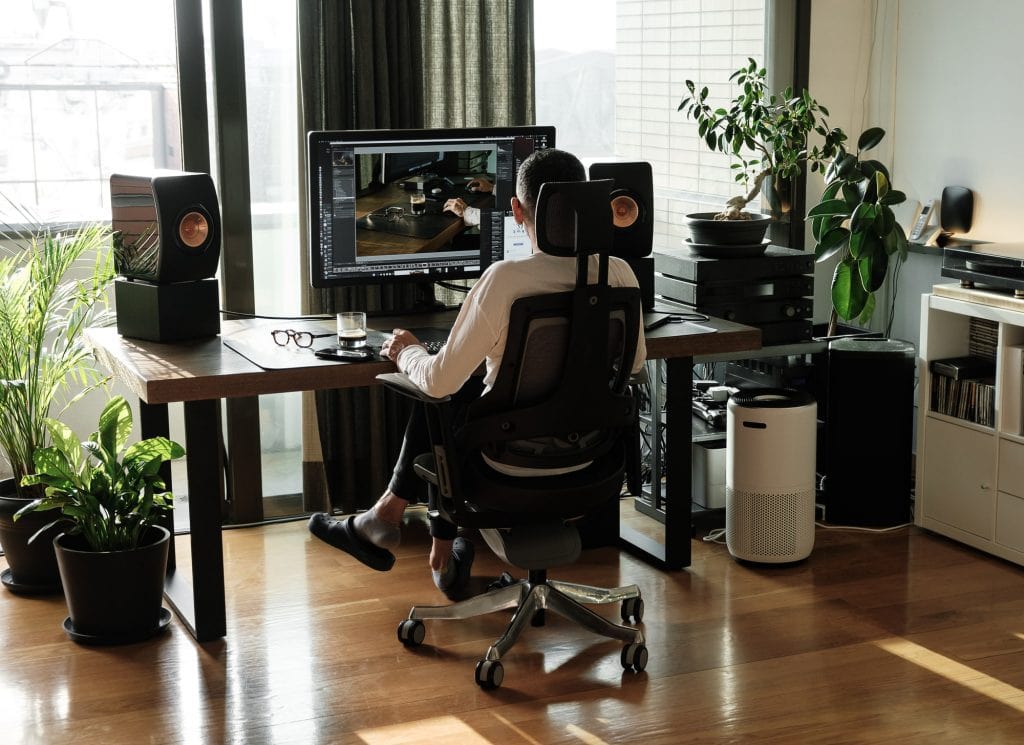
An ergonomic, comfortable chair supports your posture and keeps you comfortable. A correctly balanced ergonomic chair partners with your unique body measurements and office desk. The perfect desk chairs allow you to perform tasks:
- Specific to your job
- It keeps your spine and posture from slouching
- Demands that your body position is in line with your desk and chair
- Ensures you’re comfortable
- Prevents bad habits
- Works with your chair, computer, telephone
Desks have evolved to meet the demands of remote work and computer technology. These instrumental furniture pieces are integral to your office’s design elements. An adjustable desk allows you to alternate between sitting and standing and improves your health.
Some design principles may impact the versatility of a desk. A modern desk with clean lines or a traditional desk that echoes the past can inspire and complement your office design idea. Once you have a concept, you only need the perfect office space in a new home.
You can also integrate a dining table, kitchen table, or tall coffee table into your design elements. Ergonomic accessories impact your comfort and productivity. An ergonomic keyboard and monitor help you perform better for longer. These ergonomic tools ensure you don’t strain your hands from prolonged typing, and keeping a monitor at the precise eye level helps prevent neck strain that can lead to nagging side effects.
#2 Adequate Lighting for Optimal Focus
Lighting plays a pivotal role in any office design. The right amount and type of lighting are beneficial on several levels. It influences your mood and productivity and reduces eye strain.
Natural light sources radiate warmth and create a happier ambiance than harsh overhead or antiquated fluorescent lighting. Poor lighting can cast glare onto the computer screen and cause eye strain.
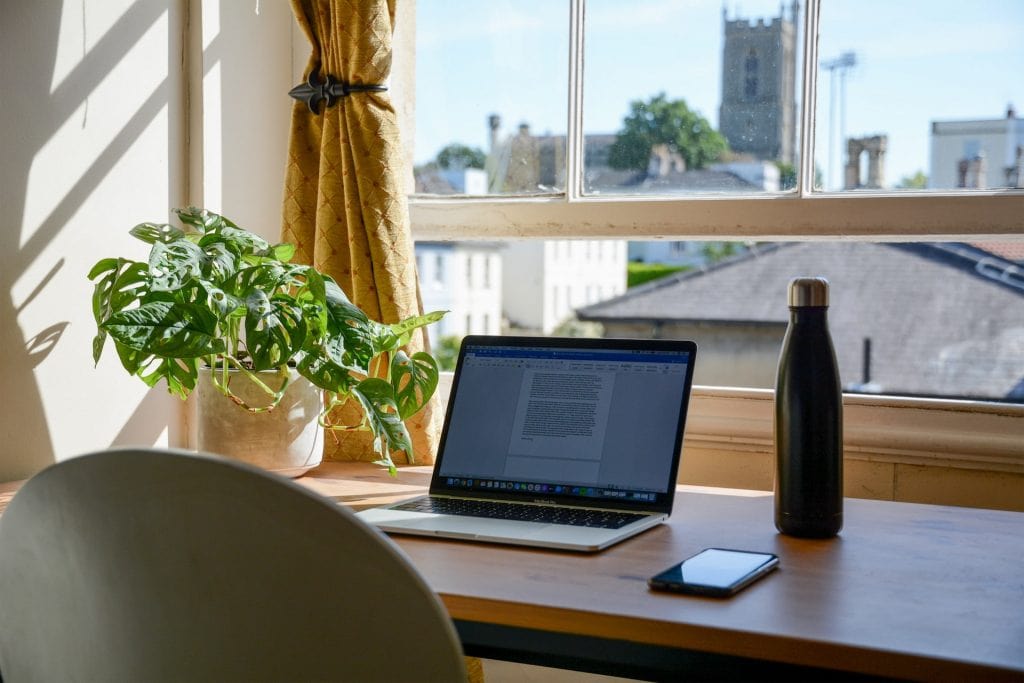
Positioning your desk near a window to utilize natural light can be refreshing and calming, especially if you view a spectacular skyline or a serene neighborhood. Adding natural elements like potted plants can also add a touch of tranquility.
Adjustable task lighting is another way to shine light onto a work surface without consuming unnecessary energy and creating excess heat. Investing in a high-quality desk or floor lamp helps you focus the light and is perfect when working late or when natural light is elusive on cloudy days.
Talk to a lighting professional about desk lamps or overhead lighting that provides soft ambient light to set a relaxed vibe. Lamps and light fixtures are an investment and can set the design tone for a home office space.
#3 Declutter and Organize for Enhanced Efficiency
A clutter-free environment maximizes productivity and helps to reduce stress. A tidy office space also promotes mental well-being. It’s not just about white walls or freeing up floor space; it’s about cultivating an environment that minimizes distractions and maximizes creativity without sacrificing personal style.
Storage solutions are also top design principles in office design trends. A littered desk hampers your workflow. Many creative and practical solutions exist to store your documents, office supplies, and office paraphernalia.
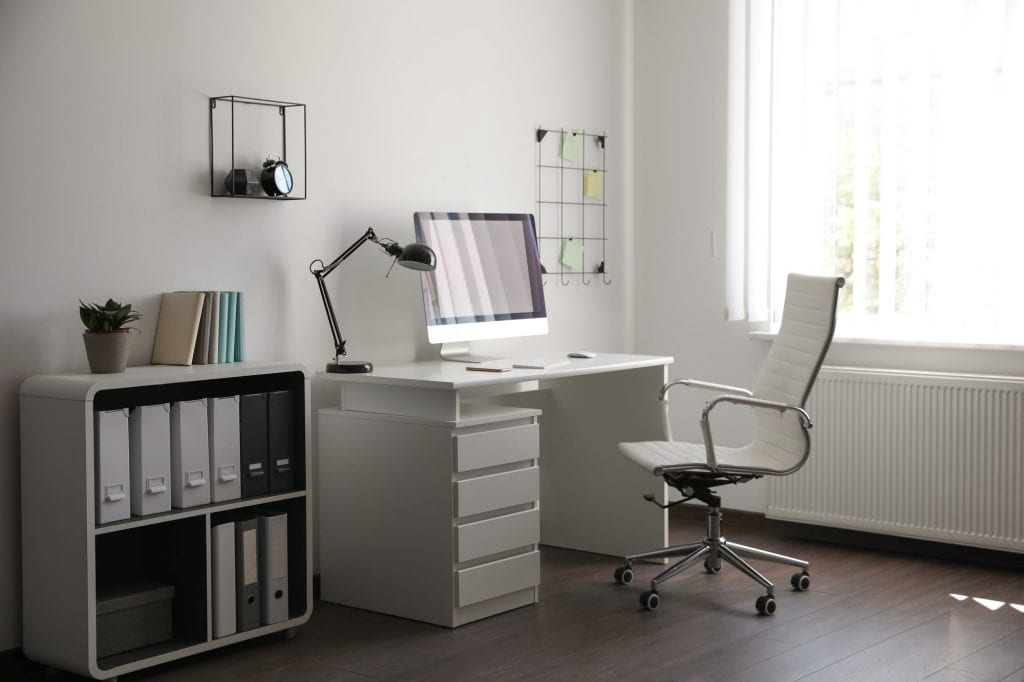
Built-in storage, like cabinets or stylish storage boxes, are an excellent solution to align your office design trends with practicality. Cabinets and desk organizers keep stationery and documents neat and secure and help with workflow.
For inspiration, visit your local office supply and furniture store. Make a list of what is truly important in functionality to you. You don’t have to sacrifice style, and many attractive and innovative storage options exist.
One of the best tricks in office space design is finding a solution to banish unattractive cables. Cable management is a must in our tech-driven environment. Coping with tangled cords is a challenge every office worker faces. Implementing a cable management system streamlines your workspace and promotes safety.
Storage space in the form of accessories like shelves, cabinets, and desk organizers are prime tools that can look great and improve performance. Great office design utilizes vertical space on an office wall with attractive shelving for decorative or practical solutions.
#4 Personalization and Inspiration for Creativity
Your office isn’t just a functional space; it reflects your style and creativity. Adding elements that resonate with you can infuse inspiration into your daily routine. Think of it as crafting an environment that energizes and motivates you.
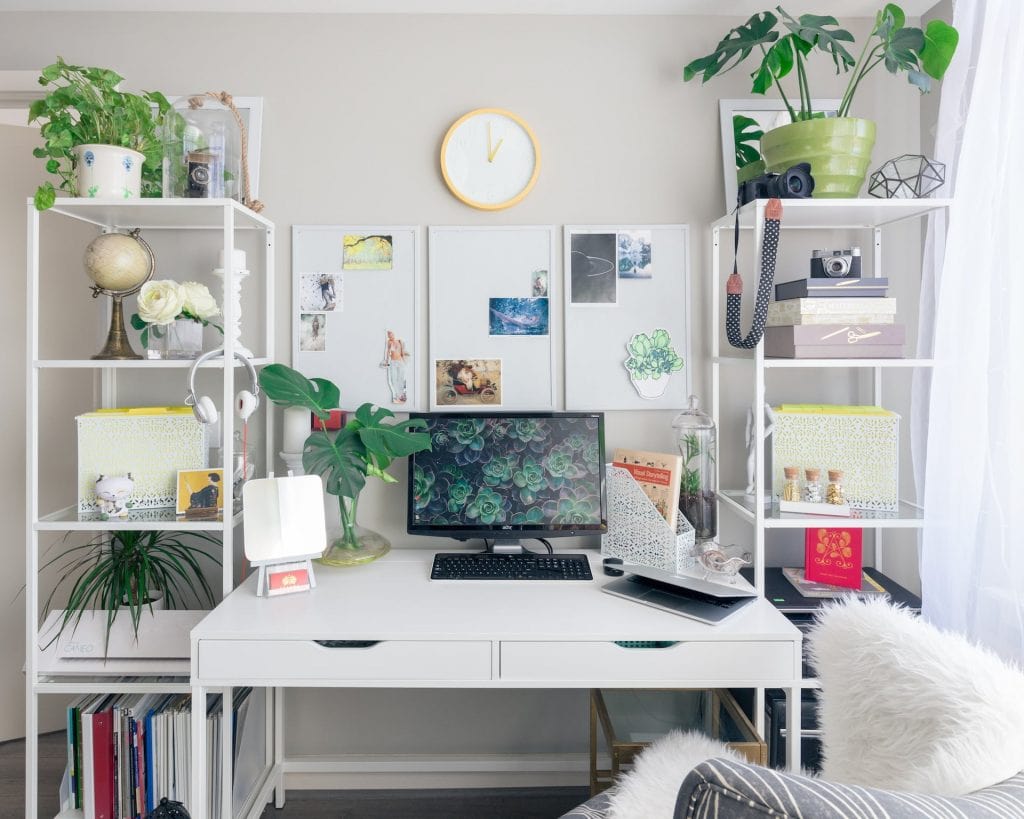
Art Work
Motivational artwork or quotes can set the tone for the day. Choose a gallery wall with a painting that inspires or motivates you. Whether it’s a quote from a renowned personality or an artwork that resonates with your office design, these elements boost morale.
Decorative Plants
Indoor plants are more than just decorative. Plants like the snake or any potted plant add a touch of greenery and enhance productivity and mood. Keep a plant on your desk, the floor, a shelf, or hanging pots. They purify air, reduce stress, and add pops of color.
Vision Boards
Vision boards are a design staple in modern office design trends. They’re not just about goal-setting; they’re visual reminders. Printed goals of professional milestones, dream destinations, or personal goals on a vision board serve as a dedicated motivational tool.
#5 Tech Upgrades for Seamless Connectivity
Having a functional home office space and quality of tech tools go hand in hand. As office work shifted to the remote worker’s home, staying abreast of tech trends became imperative to maintain productivity and streamline tasks.
A high-speed internet connection is the backbone of a modern home office. With online meetings, cloud-based collaborations, and real-time project management, a robust and reliable internet connection is non-negotiable. To be successful, you must invest in a high-speed internet connection and provider.
Upgrade your computer. This tool and its accessories significantly impact your daily tasks and your efficiency. A powerful computer, an ergonomic keyboard, and a high-resolution monitor enhance your job performance.
Although not imperative, investing in smart home integration transforms a traditional office setup into a modern functional space. Imagine controlling your office lights, temperature, and coffee machine with a single voice command. Integrations translate into convenience and add style to your office space.
#6 Soundproofing and Noise Reduction
Creating a serene and distraction-free workspace is significant. Noise disruptions hamper concentration and affect work quality and efficiency.
Soundproofing your office space is a wise investment. Acoustic panels or foam tiles can drastically reduce noise disturbances from the street or family.
Noise-canceling headphones are a modern office worker’s best friend, especially for those who don’t have a dedicated office space. These headphones create an instant quiet zone, allowing you to work undisturbed and focus on tasks. Headsets are ideal for establishing dedicated quiet hours to concentrate and boost productivity and efficiency.
#7 Incorporating Breakout Areas for Relaxation
Work without relaxation can lead to burnout. A well-thought-out office design idea incorporates spaces that allow for brief respites, ensuring that the mind remains sharp and creativity flows.
Every office needs a cozy corner. Whether it’s an ergonomic, comfy chair or a bean bag, having a spot to rejuvenate should be part of the home office space design. Remind yourself that it’s okay to enjoy a refreshing beverage and a break to recharge.
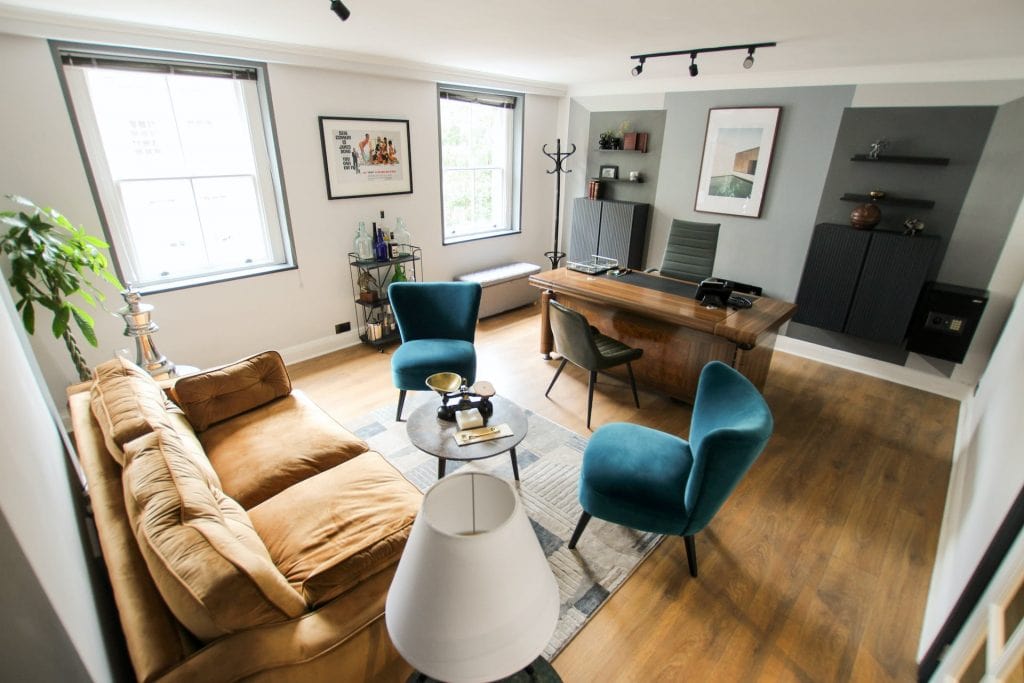
A mini-fridge or a coffee station is a delightful addition to your office space. Having refreshments close means you don’t have to leave your office.
Creating a relaxing space by surrounding yourself with plants and calming decor creates a sanctuary within your office. Incorporating natural elements, color, art, or a mini waterfall can transform an ordinary space.
#8 Future-Proofing and Flexibility
In an evolving world, adaptability is essential. Your home office space should serve your current needs and be flexible enough to adapt to future requirements. Your space needs to grow with you whenever there’s a shift in your career, an upgrade in technology, or a change in office design trends.
Designing a modular and adaptable workspace is essential. Use L-shaped desks and adjustable shelves, or upgrade a favorite dining room table into a serviceable desk. If you get the basics of your design right and your work needs change, your office can quickly transition.
Technology doesn’t rest, and investing in tech that can be upgraded, like modular PCs or monitors with versatile connectivity options, allows you and your office to remain current. Cloud-based solutions are great for integrating across devices, ensuring you’re always connected and updated.
The global shift toward remote work has made many professionals explore hybrid work arrangements. A dedicated office space at home allows people the flexibility to work from home and a corporate office simultaneously. It offers flexibility and the best of both worlds.
Key Takeaways
A well-designed and equipped home office space is necessary in today’s professional landscape. The knowledgeable eXp agents understand that remote work and balancing an office design is a significant part of a home search.
Adequate lighting, organization, and design aren’t trivial but tools that help you perform at your best. It also means drawing on technology, making improvements like soundproofing, utilizing efficiency with design principles, and relying on ergonomics to enhance your performance.
When you’re ready to shape your home office space, or to explore homes with built-in office spaces on the market right now, check out our property listings in your desired area. You can filter your search to any criteria you’re interested in, or sign up for daily or weekly updates when new listings come on the market.
FAQs: Home Office Space
Investing in real estate and creating a home office space is a big step. We have compiled some frequently asked questions, so if you still have questions, it may be answered below.
How do I make space for my office at home?
Find the dead spaces or underutilized areas in your home. Turn a guest room or bonus room into a multipurpose space. Or, if you’re limited on square footage, look for an unused corner, under the stairs, or even a large closet, and turn them into a dedicated office nook.
What is the best room for a home office?
Ideally, the best room for a home office is a quiet room with ample space, good natural light, minimal foot traffic, and low street noise.
How much space do you need for a home office?
It depends on your job requirements and how much desk space your computer, office supplies, and other instruments you need. A minimum of 50-75 square feet is a good start for a semi-functional home office.
Should you put a desk in front of a window?
Placing a desk before a window can offer great natural light and a pleasant view. However, direct sunlight causes screen glare.
Can my home office be in my bedroom?
Yes, but create a clear distinction between your work and sleep space. Using room dividers or different color schemes can help or sacrifice closet space to make a mini-office.
What are the 3 general rules for qualifying your home office as a business expense?
Always discuss this with your tax accountant, but here are the basics:
- Exclusive and regular use: The space must be used solely for business.
- Principal place of business: It should be the primary location where you conduct your business.
- No other fixed location: You don’t have another place where you conduct substantial administrative tasks or management activities.
A harmonious blend of innovation and functionality, solar roofs are becoming an increasingly popular choice among homeowners looking for energy efficiency. Not only do they play a pivotal role in slashing energy bills, but they also offer a greener alternative to conventional power sources.
Are you curious about the ins and outs of solar roofing and contemplating whether it’s a suitable option for your home? If you’re considering moving to a property equipped with such a forward-thinking feature, consider starting your journey with eXp Realty and reading this guide.
What is a Solar Roof?
At its core, a solar roof is more than just a roof. Imagine a conventional roof but with the ability to generate electricity. That’s the essence of a solar roof. Instead of merely serving as a barrier against external elements like rain, wind, or snow, a solar roof elevates the purpose of the conventional roof.
It directly integrates photovoltaic panels or solar shingles – designed to harness sunlight’s immense power– into the roofing structure. This ensures a seamless and aesthetically pleasing appearance and turns the entire roof into a power generator.
How Does Solar Roofing Work?
If you’re wondering how a solar roof produces electricity, it’s quite the marvel of modern technology. These roofs employ solar cells embedded within the solar panels or solar roof tiles, often made from monocrystalline or polycrystalline silicon. When sunlight strikes these cells, a fascinating process begins.
Sunlight is made up of tiny particles known as photons. When these photons strike the solar cells, they dislodge electrons from their atoms. When these electrons pass over a circuit, they produce direct current (DC) electricity.
However, most homes and appliances run on alternating current (AC) electricity. So, before this DC electricity can be used, it goes through an inverter, transforming it into AC electricity. The result? Usable electricity that can either power your home appliances or be fed back into the grid, often leading to credits on your electricity bills.
The integration of solar technology into roofing materials, such as tiles or shingles, allows homeowners to maintain their home’s architectural style and aesthetics without the need for bulky solar panel installations.
The Benefits of Solar Roofs
A solar roof isn’t just about aesthetic appeal or technological marvel; it benefits homeowners and the environment.
Investing in solar roofing has many advantages, from making a positive impact on the environment to saving money. Let’s explore some of these benefits.

Environmental Advantages
The significance of renewable energy sources cannot be stressed enough, especially in today’s climate-conscious world. By opting for a solar roof, homeowners contribute to several environmental benefits:
- Reduction in Carbon Footprint: Every kilowatt-hour of solar energy produced reduces the need for conventional fossil fuel-based power. This means fewer carbon emissions, a primary cause of global warming. With a solar roof, homes transition towards a low-carbon future, aiding in the global fight against climate change.
- Lower Greenhouse Gas Emissions: Solar roof installations directly contribute to reducing greenhouse gas emissions. By harnessing the sun’s clean energy, we significantly reduce the demand for non-renewable energy sources notorious for emitting harmful gasses into the atmosphere.
Financial Advantages
While the environmental benefits are evident, solar roofs also make a lot of financial sense:
- Savings on Electricity Bills: One of the most immediate and tangible benefits of a solar roof is reducing electricity costs. As you generate your own solar electricity, dependence on the utility grid decreases, often dramatically lowering electric bills.
- Potential for Tax Incentives and Rebates: Governments and state agencies worldwide are encouraging the adoption of renewable energy. As a result, homeowners can avail of tax credits, rebates, and other financial incentives that significantly reduce the average cost of solar installations.
- The Federal Tax Credit: This is one such incentive that can cover a substantial portion of the installation costs.
Energy Independence and Resilience
With a solar roof, homeowners move towards greater energy autonomy:
- Protection Against Rising Energy Costs: Traditional energy prices can be unpredictable. With your source of energy production, you safeguard yourself against potential hikes in energy costs.
- Reliable Power During Grid Outages: Paired with energy storage solutions like home batteries, solar roofs can provide power even during grid disruptions.
- Increase in Property Value: Homes equipped with solar roofs often witness a rise in property value. As the demand for energy-efficient homes grows, properties with installed solar systems become increasingly attractive to potential buyers.
- Durability and Warranty: Leading solar products, such as the Tesla Solar Roof, come with a 25-year warranty, guaranteeing long-term performance. These roofs are designed to withstand harsh weather conditions, ensuring longevity.
- Aesthetically Pleasing: With products like solar shingles and solar tiles, homeowners no longer need to compromise on the aesthetic appeal of their homes. Solar roofs seamlessly integrate with the architectural design, offering an elegant solution without the bulkiness of traditional solar panel systems.
Considerations to Keep in Mind When Choosing Solar Roofing
Transitioning to a solar roof is undeniably beneficial for both the environment and your wallet. However, like any significant home improvement project, there are key considerations to account for before leaping.
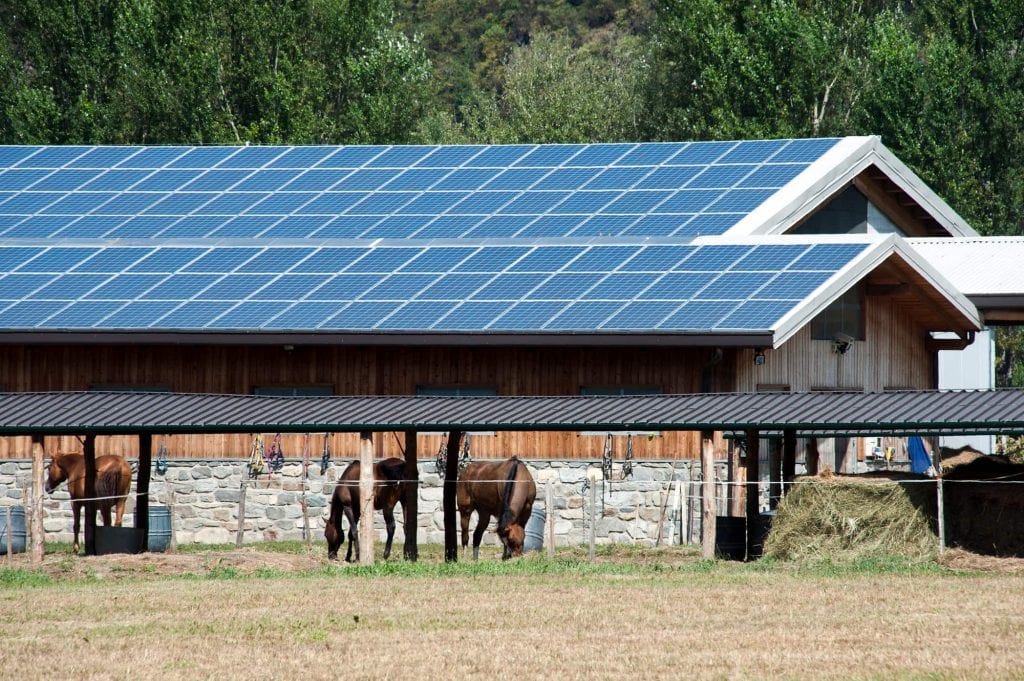
Knowing these can help you navigate the process smoothly and maximize your solar investment.
Roof Suitability Assessment
Before considering any solar installation, it’s crucial to determine if your roof is suitable for adding solar panels or tiles.
If your current roof is nearing the end of its lifespan, it might be worth considering an entire roof replacement with integrated solar products. On the other hand, if your roof is relatively new, mounting solar panels might be more appropriate. Assessing the roof’s condition will also help you avoid potential future complications, ensuring the longevity of your solar system.
Roofing Material Compatibility With Solar Installation
Not all traditional roofing materials are conducive to solar installations. Traditional asphalt roofs are commonly compatible, but if you have a concrete tile roof or some sort of metal roofing, like a steel roofing tile, you’d want to consult with a roofing company and solar company to understand the installation implications. Additionally, the roof shape, slope, and orientation play a vital role in the solar system’s efficiency.
Financial Considerations
Investing in a solar roof requires a significant initial outlay, so it’s essential to understand the complete financial picture:
Initial Installation Cost and Budgeting
Beyond the cost of the solar products, the installation cost can vary based on the complexity of the project and the chosen solar company. Get multiple quotes, factor in potential upfront costs, and ensure it aligns with your budget.
Return on Investment (ROI) and Payback Period
While the initial investment might be high, the long-term energy savings can be substantial. Factor in energy bill savings, potential increases in property value, and available solar tax credits and rebates to calculate your ROI.
Energy Consumption and System Size
The efficiency and effectiveness of your solar roof will depend on tailoring the system to your home’s energy needs:
Analyze Energy Needs and Usage Patterns
Review your past electricity bills to understand your household’s energy requirements before deciding on the solar system’s size. This will help estimate the energy production you need from your solar roof.
Determine the Optimal Size of the Solar System
Once you’ve gauged your energy needs, work with a solar company to determine the system size that will most effectively meet those requirements, considering current and future consumption patterns.
Local Regulations and Permits
Legal frameworks can vary based on location, making it essential to familiarize yourself with local requirements:
Understand Zoning and Building Codes
Depending on your location, specific zoning regulations or building codes may be related to solar installations. For instance, homeowners in South Carolina might have different requirements than other states.
Navigate the Permit Application Process
Most solar installations require a permit. Engage with local authorities or your chosen solar company to understand the permitting process, ensuring your solar project adheres to all local regulations.
Maintenance and Long-Term Considerations
As with any significant home improvement project, transitioning to a solar roof doesn’t end at installation. Proper maintenance and understanding of the long-term implications can ensure you reap the benefits of your investment for years to come.
Regular Maintenance Tasks
Solar roofs are relatively low-maintenance. However, some routine tasks can keep the system running optimally:
- Cleaning: Depending on your location, dust, debris, or even snow can accumulate on your solar panels or solar roof tiles. Periodic cleaning ensures maximum power output and efficiency. Be cautious and consider hiring professionals, especially for steep roofs.
- Monitoring System Performance: Today’s solar systems have monitoring tools to check energy production and overall system health. Regularly checking this can help identify any potential issues or drops in performance early on.
Warranty Coverage and Repairs
Understanding your warranty and potential repair needs can save you from future hassles:
- Dealing with Potential Issues or Malfunctions: While solar modules are designed for durability, issues can arise. If you notice a significant drop in energy output or other abnormalities, contact your solar company for diagnostics and repairs.
- Lifespan and Replacement Considerations: Most solar products come with a 25-year warranty, whether it’s a power output warranty or a product warranty. However, the lifespan can often exceed this, with some performance degradation over time. Plan for potential replacements or upgrades, especially as solar technologies advance.
Key Takeaways
Embracing a solar roof is more than just an eco-friendly choice; it’s a testament to the future of clean energy and sustainable living. The numerous benefits range from significant energy savings and reduced electricity bills to substantially decreasing one’s carbon footprint.
The shift towards renewable energy sources, like solar power, is not just a trend but a necessary evolution to address the world’s growing energy demands sustainably. As you consider transitioning to a solar roof, remember the considerations and steps outlined in this guide, ensuring you make informed and effective decisions for your home.
To explore more on solar roofs or even properties for sale that come with it, contact a local eXp agent.
FAQs: Solar Roof
Given their increasing popularity and the constant advancements in solar technology, solar roofs naturally give rise to many questions. Here are answers to some frequently asked questions:
How much is a solar roof for a 2,000 square feet house?
The solar roof costs for a 2,000 square feet house varies based on location, specific solar products, and installation complexities. Considering products like the Tesla Solar Roof or a full roof replacement plus GAF solar shingle installation by GAF Energy, prices might range between $30,000 to $50,000 before incentives and tax credits. However, always get quotes specific to your circumstances before starting your solar energy journey.
Is a solar roof a good idea?
Absolutely. Solar roofs offer environmental benefits, like reduced carbon emissions, and financial advantages, such as energy savings and tax incentives. They can also increase property value and offer energy independence.
What is the disadvantage of a solar roof?
The most common disadvantages of a solar roof include the high initial installation cost, potential complexities based on roof shape or material, and the dependency on sunlight, meaning energy production can be variable.
Does a solar roof pay for itself?
In many cases, yes. With energy savings, increased property value, and available solar tax credits, the return on investment can mean the system pays for itself, typically between 5-10 years.
Is a Solar Roof cheaper than solar panels?
Solar roofs, which integrate solar cells into the roofing material, can sometimes be more expensive initially than traditional solar panel installation on an existing roof. However, if you’re considering a roof replacement, integrating solar can prove cost-effective in the long run. Always compare costs specific to your situation.
Is it cheaper to install solar on the roof or ground?
Roof installations are generally cheaper due to fewer required materials and groundwork. However, ground installations offer more flexibility for optimal sun positioning.
Does a solar roof reduce heat?
Yes, solar roofs can reduce heat absorption, often leading to cooler attic spaces and potentially lower cooling costs in warmer months.
Why don’t more people have solar roofs?
People hesitate to adopt solar roofs because of upfront costs, lack of awareness, regional sunlight variations, and aesthetic concerns.
How long can a house run on solar power alone?
Depending on system size, energy consumption, and storage capabilities, a house could run indefinitely on solar power alone, especially with battery backups for nighttime or cloudy days.
Is solar better in winter or summer?
Solar panels are typically more efficient in cooler temperatures. However, longer daylight hours in summer can lead to higher energy production, even if efficiency is reduced due to heat.
]]>According to Tourism Economics, the island experienced a staggering surge in revenue from travel and tourism in 2022, reaching a remarkable $8.9 billion. This figure represents a 39% increase compared to the previous record set in 2019.
If you’re a second-home buyer curious about Puerto Rico, know that investing here has simpler processes and paperwork than anywhere else in the Caribbean, thanks to its status as an unincorporated U.S. territory.
Whether you’re looking for an oceanfront single-family home to use as a relaxing beach retreat or a bustling condo surrounded by city lights, La Isla has options at every cardinal point. In this guide, we’ll explore the top nine destinations to purchase a vacation home in Puerto Rico. So sit back, relax, and let us guide you through the process of owning a piece of paradise.
The Puerto Rico Real Estate Market
Puerto Rico stands as a premier vacation and second home spot for U.S. citizens due to its status as a U.S. territory. The island’s enticing tax incentives provide another compelling reason to invest in property in Puerto Rico.
In fact, the implementation of Puerto Rico’s Act 60 in 2019 – which offers tax exemptions to businesses and investors who choose to relocate or establish themselves on the island, requires the purchase of property within two years of receiving a decree.
The real estate market in Puerto Rico is currently favoring sellers, characterized by high demand but limited inventory for buyers seeking primary residences. However, buying vacation homes or investing in real estate for rental profit is relatively easy and has become an attractive prospect for U.S. citizens due to the popularity of short rentals on the island.
As stated by a local agent, “the short-term rental market is flourishing in both the coastal areas and the countryside.” Currently, the Puerto Rico real estate market boasts an average price of $150K. However, whether you prefer upscale or budget-friendly options, a wide range of properties are available to cater to diverse budgets.
Benefits of Buying a Vacation Home in Puerto Rico
- Tax Benefits: Incentives such as Act 20 and Act 22 offer reduced corporate and individual tax rates, making Puerto Rico an attractive location for entrepreneurs, investors, and retirees.
- Lower Cost of Living than the Mainland: Puerto Rico offers a lower cost of living than many parts of the U.S. mainland, making it an appealing destination for those looking to stretch their dollar a bit further during vacation.
- Year-round Beautiful Weather: Weather is one of the top perks of owning a vacation home in Puerto Rico. The island boasts year-round sunshine allowing visitors and residents to enjoy its offerings.
- Access to Some of the Best Beaches in the Caribbean: Picture yourself lounging on pristine white sand, watching the turquoise blue waves gently lure you in for a swim. The island has award-winning beaches like Flamenco Beach. With a second home in Puerto Rico, this dream can be a short plane ride away.
- Rich Culture and History: Puerto Rico has a Caribbean and Latin American identity, a rich past filled with pirates and rebels, and a culture defined by vibrant festivities, colorful traditions, salsa music, traditional cuisine, art, literature, architecture, and more.
- A Caribbean Lifestyle with American Advantages: As an American Commonwealth, Puerto Rico enjoys the same currency, language, and government as the mainland, making it an ideal destination for homebuyers and investors who may not feel comfortable acquiring property in other countries.
- Opportunity to Explore the Whole Island: With 5,325 square miles of territory and abundant beaches, mountains, and natural beauty, Puerto Rico is a small island you can explore with your car from the comfort of your vacation home.
Top 9 Destinations To Purchase a Vacation Home In Puerto Rico
Vieques
Vieques, officially known as La Isla de Vieques, is one of the five smaller islands surrounding Puerto Rico. It is situated only eight miles off the eastern coast of the main island, a 30-minute ferry ride. The island is a haven for nature enthusiasts and a paradise for tourists seeking a genuine escape from it all.

Renowned for its unspoiled beauty, Vieques beckons with endless stretches of pristine white-sand beaches, inviting visitors and residents to wander and discover. Here, you can immerse yourself in the Caribbean waters, perfect for swimming, scuba diving, or snorkeling. Ecotourism enthusiasts can explore the wildlife preserves.
If you want to purchase a vacation home in Puerto Rico, Vieques is a more private, simple living option. Here, you will trade large malls and department stores for charming farmers’ markets and little “colmados.” Also, be ready to see roaming horses and chickens, and to have beach wear and snorkeling gear stashed in your car, ready for a spontaneous adventure.
Vieques presents an enticing market for individuals looking for beachfront properties, whether as a primary residence, a vacation retreat, or a lucrative business venture. The Vieques real estate market is experiencing high demand, especially from foreign investors, while the supply of properties remains limited. As a result, the prices have soared, with a median price of $324K.
The waterfront properties and land for sale in Vieques are highly coveted and regarded as perfect vacation retreats or lucrative investments. These properties will be utilized as summer hideaways for snowbirds and families or as beachside short-term rentals. Given that Vieques lacks large resorts, any dwelling can be easily converted into a cute motel or B&B, presenting a profitable business prospect.
- Attractions & Landmarks: Puerto Mosquito, Vieques National Wildlife Refuge, Crab Island Rum Distillery, La Chiva Beach, Caracas Beach, Playa Negra.
- Median sale price: $324K
- Zip code: 00765
Dorado
Safe, paradisiac, and filled with luxurious real estate options by the water, Dorado is a desirable enclave to buy a second home close to San Juan’s action. The town, located just 15 miles (24 km) west of Puerto Rico’s capital, is considered a San Juan suburb, and has been praised for its quiet atmosphere, water-centered recreation, and day-to-day amenities.

The allure of Dorado is that, even though it is a well-known tourist destination for both locals and foreigners, it doesn’t feel crowded at all. It is actually pretty quiet and laid-back. Most of the activity and services are concentrated in the northern portion of town, while the south is more sparsely populated and peaceful.
Dorado encompasses five neighborhoods and Dorado Pueblo, but the Dorado del Mar community is one of the top living options for second-home buyers. This luxurious coastal area offers a variety of vacation homes, ranging from cozy bungalows to sprawling estates near the sea. Dorado del Mar provides access to breathtaking beaches and views, small restaurants with live music/karaoke, shopping, and entertainment.
Dorado real estate is in a thriving market where second-home purchasers can acquire a variety of condos in waterfront golf course communities. The single-family homes for sale are also in high demand, with prices ranging between $685K and $36M. The best listings are new custom-built mansions of up to seven bedrooms and lots of over 9,000 square feet.
Foreign investors prefer to buy Dorado real estate that is new construction and located in top communities within resort properties, like Dorado Country Estates and Villa Dorado Estates. This ensures 24-hour security, top-notch maintenance of the property, and access to world-renowned amenities such as golf courses, a beach club, a spa, a fitness center, water sports facilities, private beaches, and more.
- Attractions & Landmarks: Dorado Beach East Golf Course, Playa del Dorado, El Ojo del Buey Trail, Kikita Surf Beach, Gran Parque Agroturístico Ecológico Recreativo El Dorado.
- Median sale price: $1.3M
- Zip code: 00646
Isabela
Nestled on the island’s northern coast, Isabela is a charming town and municipality where real estate is affordable, and life moves at a different pace. If you’ve decided to purchase a vacation home in Puerto Rico, Isabela has beautiful beaches, lush greenery, and an inviting atmosphere.

Isabela is the quintessential beach town, perfect for a weekend escape or a long vacation from the hustle and bustle of city life. Its beaches cater to surfers, swimmers, and snorkelers alike, offering a delightful retreat for all water enthusiasts.
For hikers and campers, Isabela is home to a state forest, and for those seeking a touch of luxury, indulge in exceptional cocktails at the local luxury resorts. No matter your preference, this town is the perfect destination to unwind.
Looking for second homes in Isabela? The top areas to invest in are those in the northern portion of town, where investors can buy renovated two-bed condos for $485K or properties with short-term rental potential, like an eco-friendly 10-bedroom single-family home on Bajuras Beach with a swimming pool and 4,900 square feet lot. More affordable dwellings await in southern Isabela, with fixer-uppers selling for around $100K.
Isabela’s economy thrives on tourism, so there are services and comforts available for vacationers and residents alike. If you visit you’ll find several lodging options, from hotels and guesthouses to luxurious resorts. There are also restaurants, cafés, bars, shopping centers with options ranging from small boutiques to brand-name stores, farmacies, and supermarkets.
- Attractions & Landmarks: Playa Jobos, Guajataca State Forest, Montones Beach, Pozo Teodoro, Castillo Labadie.
- Median sale price: $170K
- Zip code: 00662
Rio Grande
Considered a suburb of San Juan, Rio Grande is a nice area to own property in La Isla del Encanto based on safety, cost of living, real estate prices, and access to amenities and ocean-focused recreation. Famous for being home to El Yunque National Forest and many scenic beaches, Rio Grande offers diverse housing options in northeast Puerto Rico.

If you’re planning to purchase a second home in this area, you can keep yourself busy in El Yunque, the only tropical rainforest in the U.S. National Forest System. You can hike to one of its many natural pools, or practice wildlife viewing, ziplining, ATV riding, or horseback riding. For beach relaxation, the coastline of Rio Grande houses Las Picuas Beach, with tan sands and sapphire waters in the shade of palm trees.
With tourism as its main economic sector, Rio Grande has many hospitality businesses, from little hotels to luxury beach resorts, including St. Regis Bahía Beach Resort, and Wyndham Grand Rio Mar Puerto Rico Golf & Beach Resort. There are also many restaurants and eateries, as well as shopping and entertainment spots serving the area.
The real estate market in Rio Grande shows healthy trends with rising prices and a high volume of foreign sales, particularly in resort communities and upscale areas. The property supply consists mostly of condos and single-family homes, with prices ranging between $85K for undeveloped real estate and $8M for a four-bedroom, fully-furnished condo in resort property with access to luxurious amenities.
As one of the largest municipalities east of San Juan, there’s no limit to what the Rio Grande real estate market offers homebuyers. However, if it’s a vacation home you want, the top alternatives are in the northwestern portion of town. Gated communities like Las Casas at Coco Beach and condo complexes with golf courses and ocean views, like Las Verandas at Bahia Beach Resort, will not disappoint. Still, you may have to pay top dollar for properties there.
- Attractions & Landmarks: Coco Beach, El Yunque, Indio Cave, Las Picúas Beach, The Saint Regis Bahia Golf Course, Carabalí Rainforest Park.
- Median sale price: $480K
- Zip code: 00745
San Juan
Looking for Puerto Rico vacation homes? You’ll want to buy yours in San Juan, the country’s capital. San Juan presents prospective residents with the opportunity to relish an authentic Caribbean lifestyle, paired with the added advantage of American amenities and privileges.

Living in San Juan, Puerto Rico, even if it’s for a few weeks or months every year, can be a life-changing experience. This vibrant city is home to breathtaking beaches, colorful architecture, and a rich history. The city is a melting pot of different cultures, in which Spanish and Caribbean influences are predominant, creating a unique, inviting atmosphere.
The real estate market in San Juan is the most dynamic and high-valued of the island, and you’ll find literally any dwelling type you desire here. For urbanites looking for upscale amenities, entertainment, recreational activities, and waterfront views, condos in San Juan have a typical value of $400K.
The best neighborhoods for condo investors include Old San Juan and Condado, both offering existing units and new construction. As premier locations to live in the city, these condos (commonly on mid or high-rises) can be priced in the millions and offer upscale amenities, walkability, and access to a top-notch quality of life.
If it’s a single-family home in San Juan you’re after, some of the safest and most well-established communities to buy are Santurce, Quebrada Arenas, Hato Rey, and Universidad. When it comes to home styles in San Juan, the options are diverse. From elegant Spanish-style villas to expansive eight-bedroom estates just a stone’s throw away from the ocean, there is something to suit every taste.
- Attractions & Landmarks: Old San Juan (El Viejo San Juan), Museo de Arte de Puerto Rico, Ocean Park Beach, Museo de Las Américas, The University of Puerto Rico Botanical Garden, San Juan National Historic Site, El Yunque National Forest, Castillo de San Felipe del Morro, Casa Bacardí Distillery, La Placita de Santurce.
- Median sale price: $234K
- Zip codes: 00901, 00907, 00911, 00913, 00924, and 00926.
Palmas del Mar
Palmas del Mar is a coveted resort community located south of Humacao, PR, on the eastern coast of Puerto Rico. For many, this is the best vacation spot in the whole country, and a premier destination for foreign buyers in search of a vacation dwelling in a gorgeous setting.

Palmas del Mar prioritizes a community-focused way of living that incorporates the housing of its 1,400 permanent residents (about 3,400 houses) intertwined with modern amenities such as top-class restaurants, shopping options, a bank, and recreational facilities. Activities residents enjoy on a regular basis include swimming at the beach club, tennis courts, a golf club, boating at the yacht club, an equestrian center for horse owners, and over 10 miles of trails around the community serving hiking enthusiasts.
By owning vacation property here, you’ll be surrounded by like-minded individuals, which makes it easier to make friends and have your social calendar permanently full. Palmas del Mar residents are a unique blend of the local culture with people from all the corners of the globe, and, of course, United States citizens.
Real estate is always in high demand in Palmas del Mar, so if you’re seriously considering this community, contact a local real estate agent to start making the arrangements right away. The median sale price is around $775K, but what you’ll pay will depend on the property type you choose and other factors like location and square footage.
The Palmas del Mar real estate market offers low-maintenance living in the form of lovely condos with open ocean vistas, perfect for retirees and singles. There are also townhouses and single-family homes for families and couples seeking more space. Some detached dwellings can boast up to 4,000 square feet, gorgeous panoramic views, a pool, and much more.
- Attractions & Landmarks: The Yacht Club Marina at Palmas del Mar, Palmas del Mar Beach, Beach Village Golf Course, Secret Beach, The Pterocarpus Forest.
- Median sale price: $750K
- Zip code: 00791
Culebra
Tiny, secluded, and sparsely populated, Culebra is an exotic place to own vacation property in Puerto Rico. Here, you’ll move around by bike or golf cart, spend your days fishing, swimming in award-winning beaches like Flamenco Beach, and exploring the abundant nature preserves filled with lush forests packed with wildlife.

You’ll enjoy activities like hiking, biking, paddleboarding, kayaking, and bird-watching from your vacation home in Culebra. If you like underwater adventures, you can do snorkeling or scuba diving. All recreation in Culebra comes with the backdrop of gorgeous views and beautiful weather all year long. Summers bring heat, with temperatures ranging from 75°F to 87°F. As for winters, they are practically non-existent, leaving the chill far away.
For a small town, Culebra has a wealth of culture and history. Explore the island’s charming neighborhoods and immerse yourself in unique cultural and architectural treasures that will leave you in awe.
Explore the rich history of Culebra at the Museum Fort Count Mirasol and Culebra Historical Museum. After learning the local way of life, treat your taste buds to delectable dishes at the eateries and restaurants that offer everything from comida criolla (creole food) to classic tacos, pizzas, and burgers.
With limited inventory due to its small size and high demand from investors and homebuyers attracted to the abundant natural beauty and recreational options, Culebra has a strong real estate market with soaring housing prices. The island offers diverse properties, from beachfront villas to mountaintop retreats.
- Attractions & Landmarks: Flamenco Beach, Tamarindo Beach, Playa Carlos Rosario, Culebra National Wildlife Refuge, Playa Resaca, Playa Sardinas.
- Median sale price: $565K
- Zip code: 00775
Rincón
The beach town of Rincón lies in the northwestern corner of the island of Puerto Rico and it’s widely known for its laid-back atmosphere, friendly locals, and vibrant surf culture. Rincón is the type of place where you get around on a bike or a four-wheeler, wear flip-flops everywhere, and know everyone by name.
As a tiny seaside village, Rincón has limited amenities, like small boutiques and markets, community health centers, and family-owned, informal eateries. The local economy revolves around tourism, with many hotels and other forms of lodging leading the main source of revenue. With its numerous local surfing schools, Rincón lures water sports enthusiasts from both nearby and distant locations.
In addition to catching a wave, there are countless activities to enjoy here. Explore the underwater world through snorkeling, glide across the water on a kayak, embark on a horseback riding adventure, or pedal along scenic mountain biking trails. Whale watching and fishing are also popular options. And if you simply want to unwind, bask in the sun on the beach while admiring Rincón’s breathtaking pink sunsets.
Ready to invest in a vacation home in Rincón? The Rincón real estate market remains competitive with a median sale price of $300K, up 7.5% since the previous year, which shows appreciation but also certain affordability. Properties remain for approximately 36 days in the market before closing.
Most coveted dwellings on the market are located along the coast to take advantage of the ocean views and beach proximity. Prospective second-home buyers can still find a large variety of properties in Rincón, including condos with luxurious on-site amenities, single-family homes, and land for sale.
- Attractions & Landmarks: Faro Punta Higueras, Domes Beach, Reserva Marina Tres Palmas, Balneario Público Rincon, Dona Lala Beach, El Último Brinco, Playa Los Almendros.
- Median sale price: $300K
- Zip code: 00677
Carolina
Located directly east of San Juan, on Puerto Rico’s northeast coast, Carolina is the country’s third-largest city and boasts 203K residents. Known for being the hometown of baseball hall-of-famer Roberto Clemente and other local heroes, one of Carolina’s major drawings for potential homebuyers is the presence of the island’s main airport, Luis Muñoz Marín International Airport (SJU), making the area perfect for frequent travelers.

The town boasts stunning beaches, delicious food, and colorful cultural events where you can integrate with the community and maybe learn some Spanish. Moreover, owning a second home in Carolina, PR, will allow you to experience the island’s relaxed atmosphere while enjoying all the comforts of home.
Things to do for vacationers in Carolina include the two main beaches: Isla Verde Beach and the Balneario de Carolina. Both beaches are great for swimming and relaxing under a palm tree or for practicing windsurfing and kitesurfing if you’re adventurous. Renting wave runners, banana boats, or a catamaran tour are popular plans for families.
The Carolina beaches are located within walking distance from restaurants, eateries, and stores if you need a snack after the fun. The city also boasts museums, like El Museo del Niño or the Galería de los Gigantes Museum, where you can have an interactive experience and immerse in the local culture and history.
Its own attributes and proximity to the capital, San Juan, make Carolina a fantastic place to own a second home either for yourself or to use as a business venture. Carolina real estate has a diverse market with condos, townhouses, and single-family homes priced between $120K and $2M. However, the properties with the highest demand are oceanfront in neighborhoods like El Palmar, Villas de Lago Mar, Villa Marina, and Parque Isla Verde.
Attractions & Landmarks: Hacienda Campo Rico, Pine Grove Surfing Beach, Playa Isla Verde, Isla Verde Park, Carolina Public Beach, Parque Julia de Burgos.
Median sale price: $460.9K
Zip code: 00979, 00983, 00985, 00987,
Buying Vacation Homes in Puerto Rico
Owning a vacation home in Puerto Rico is a dream come true for many. However, embarking on this complex transaction in a different country, even if it’s a US territory, can seem like a daunting task. Here are some of the steps you need to take before you can call yourself a proud Puerto Rican property owner:
Step 1. Securing Funding
Unless you plan to buy a home with cash, you’ll need a loan to finance the purchase of your desired home. The pre-qualification process in Puerto Rico is similar to the U.S. process; it includes a good credit score and preparing a downpayment of 20% of the price (unless it’s an FHA loan that allows a 3.5% downpayment).
You’ll also need a bilingual mortgage broker to deal with all the paperwork. Based on the intended use of your new Puerto Rico home, you can qualify for a loan ranging from 75% to 100%.
Step 2. Search for the Dream Property
If you already have a location in mind, it’s time to start your home searching process. This process includes the following:
Hire a real estate agent and lawyer: Since you’re trying to buy property in a different country, we recommend enlisting a buyer’s agent to assist you, even if they charge a hunter’s fee. A certified Resort and Second-Home Property Specialist could be even more beneficial for your Puerto Rico home search. Finding the right home or condo can be very different from the house-hunting process on the mainland and you’ll benefit from their guidance.
It is also important to hire a real estate lawyer since you’ll be navigating an unknown market in a foreign language. Engage your lawyer to assist in incorporating provisions into the purchase agreement, allowing your buying decision to be contingent upon repairs identified during a home inspection or the property appraisal.
Do a title search: Numerous properties in Puerto Rico may be unsellable due to intricate inheritance law complications, so make sure to do a title search or title study to your desired property. The property should cost around $100.
Be Careful with Listing Databases: While Puerto Rico has an MLS database, it is not widely used. The primary source for agent-represented listings on the island is Point2Homes.com. However, be ready to encounter the same house listed by multiple agents, each with different prices.
There can be low data quality, including missing or outdated information. Simply put: Did you find an incredible condo by the ocean with an unbelievable price? You may find out it was sold six months ago.
Getting reliable, comparable sales data in a place with limited MLS participation can be challenging, so what is there to do? Puerto Rico has a third-party data service called TasaMax that bank lenders, mortgage brokers, and real estate agents use for this purpose.
If you come across a property that catches your interest and you’re considering making an offer, seek the assistance of one of these professionals to generate a comparative sales report for you.
Step. 3 Closing on the Home
Property purchase transactions are typically finalized at the lending bank’s office, usually 15 to 45 days in advance. Unlike in the United States, the physical presence of all parties involved is required. This ensures a smooth and secure process, guaranteeing that all necessary parties are present to complete the transaction. Take into account that closing in Puerto Rico may not be as smooth as in the mainland and the process can last for several hours.
FAQs: Destinations To Purchase a Vacation Home In Puerto Rico
Is buying property in Puerto Rico a good idea for Americans?
Investing in Puerto Rico real estate presents a remarkable opportunity for American citizens. As a U.S. Commonwealth, the island imposes no restrictions on ownership, making it an enticing prospect.
The influx of cryptocurrency millionaires and media personalities choosing to relocate has sparked a surge in American and international investors flocking to Puerto Rico. This trend can be largely attributed to the enticing tax benefits offered by Act 60-20-22, which slashes tax rates to a mere 4%.
Do I need an agent to purchase property in Puerto Rico?
When buying real estate in Puerto Rico, working with a certified and bilingual agent with extensive experience is crucial. Keep in mind that conditions and specific details can differ based on the location where you’re purchasing property, so it’s crucial to choose an agent who possesses expertise in your particular area of interest. A person who speaks Spanish and knows the country’s culture and ways will be a great asset to your transaction.
Prior to embarking on the purchase of that dream vacation home or condo, research the local market thoroughly. Compare prices of various homes for sale and meticulously examine any potential additional fees, such as security deposits, maintenance costs, or insurance premiums. Also, consider hiring a home inspector and scheduling an in-person visit to your property if you haven’t done it yet.
What is the law 20 and 22 in Puerto Rico?
In 2012, the Government of Puerto Rico introduced two acts as part of a comprehensive plan to enhance the island’s economy. These acts, namely Act 20 (Export Services Act) and Act 22 (Individual Investors Act), aimed to attract high-net-worth individuals and businesses to Puerto Rico by offering a range of tax benefits. Let’s learn a bit more about each:
- The Act 20 program was designed to provide eligible businesses based in Puerto Rico, with clients outside of Puerto Rico, the opportunity to take advantage of various tax exemptions. These exempt businesses enjoy the benefits of a minimal corporate tax rate of only 4%, a complete exemption from taxes on dividend distributions, and other tax advantages, which we will delve into further below.
- Act 22 sought to encourage investment in Puerto Rico by providing substantial tax incentives to legitimate residents. Investors who fulfill the residency requirements can enjoy tax exemption on dividends, interests, capital gains, and even crypto assets, resulting in significant financial benefits.
What are the potential drawbacks of buying property in Puerto Rico?
It is no secret that Puerto Rico has faced financial difficulties. The country filed for bankruptcy in 2019 but successfully emerged from it due to a remarkable surge in the local real estate market. Aside from the potential economic issues, homebuyers looking to invest in the island should be made aware of the risks associated with extreme weather.
In Puerto Rico, properties and residents are vulnerable to the increasing severity of hurricanes in tropical regions. Before making a purchase, it is crucial to carefully consider the risks and benefits associated with owning a vacation home in this Caribbean location.
]]>Whether you’re a retiree looking to escape the hustle and bustle of city life, an investor looking for rental profit, or a family seeking a vacation retreat, conch houses deliver that relaxed, inviting character. They also have many clever design features and historical significance.
Before you start looking for Key West real estate, you should educate yourself more about this housing style. In this guide, we’ll dive into the conch house style’s definition, characteristics, and features so you can decide if it’s the right fit for your lifestyle.
What’s a Conch House?
The conch house, or Bahamian house, is a type of dwelling that emerged in Key West, FL, during the 19th century and continued to be built and used in the early 20th century.
While conch houses are more abundantly found in Key West and other Florida Keys, it is not uncommon to find a few of them in the Miami area. Most Miami conch houses are in traditional neighborhoods like Overtown and Coconut Grove.
This housing style is one of the main examples of Florida’s vernacular architecture since its design and construction process involve traditional materials and resources available in the area. It is also strongly influenced by the geographical features and the cultural aspects of the environment.
Conch Architecture: A Brief History
According to the Historic Preservation Program of the City of Miami, conch architecture flourished in the Florida Keys between 1890 and the 1920s. This housing style was mostly crafted by boat builders and carpenters from the Bahamas, who settled on the island of Key West and made it their home.
The earliest conch houses were constructed with a shipbuilding method: cross-braced timber. This artisanal technique, akin to the joinery techniques used by furniture makers, uses mortise and tenon joints that are fastened using wooden pegs.
Starting from the 1880s, the construction technique of Conch Houses shifted to balloon framing. Balloon framing employed slender vertical studs that extended from the sill plate to the roof plate. This transition marked a significant change in how these houses were built.
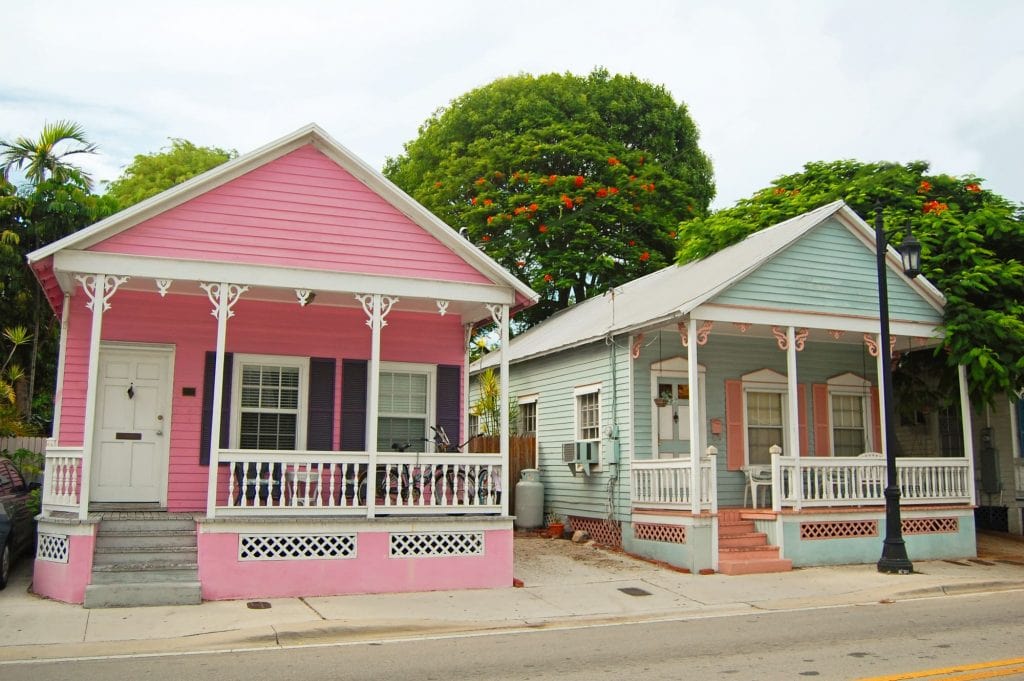
The framing system used nails instead of the joinery method employed by the early Bahamian builders. Balloon framing, being less skill-intensive, was a more cost-effective alternative to the more primitive construction methods.
Bahamians created conch houses to be weatherproof based on the techniques they used in their home country, but the style also received contributions from other cultures, like the Cubans, that broadly settled in the Keys during the 19th century as immigrants and refugees..
That’s why the style has influences from Caribbean Colonial buildings. In his book Houses of Key West, Alex Caemmerer says, “Conch houses are perhaps the finest example of Caribbean colonial architecture in the U.S.A. outside of New Orleans.”
While many of the oldest conch houses deteriorated throughout the early 20th century, the community united to refurbish and save neighborhoods like Old Town, The Meadows, and Bahama Village, “giving Key West the distinctive aesthetic profile that adds so much to its tourism appeal.”
Today, many restored conch houses in Key West are landmarks, businesses (like B&Bs), or both. The tiny island city boasts the largest historic districts of wood construction on the National Registry of Historic Places, encompassing over 3,000 wooden houses from the 18th and 19th centuries, many of which are conch houses of several designs and sizes.
Two Theories About The Origin of The Name “Conch House”
Two predominant theories revolve around the origin of the name “conch house.” The most popular and accepted one indicates that this architectural style got its name from the shipbuilders who first constructed it.
Those shipbuilders were Bahamian immigrants –known as “Conchs,” established in Key West in the 19th century. This explains the name and why early conch houses were constructed using boat-building techniques, like timber framing.
The second theory looks at the construction materials. Florida Keys early settlers had to get creative to build their homes in an environment with low material availability (there was no abundance of bricks or rocks in the area at the time) and extreme weather like prolonged heat waves and frequent storms.
They needed sturdy dwellings to withstand the elements and, at the same time, efficiently maintain cool interior temperatures. So, they built conch houses supplementing available amounts of stone and wood with a mortar mixture of sand, water, and lime residue derived from burnt conch shells, which is how they acquired their distinctive name.
Design and Construction Elements of a Conch House
Conch houses are considered vernacular constructions due to the practicality of their designs, but they also showcase a blend of stylistic influences, including elements of classic revival and neoclassical architecture.
Classic examples of the conch house have rectangular ground plans –defined by Key West’s narrow lots, one to two-and-a-half stories, and are of wood construction. In the early years, shipwreck wood was a cheap raw material commonly utilized.
Dade County pine was also broadly used due to its availability, density, and high resin content, which protected it from termites. Since Dade County pine is not available anymore, other types of wood started to be used to build and refurbish conch houses, including cedar, yellow pine, and cypress.
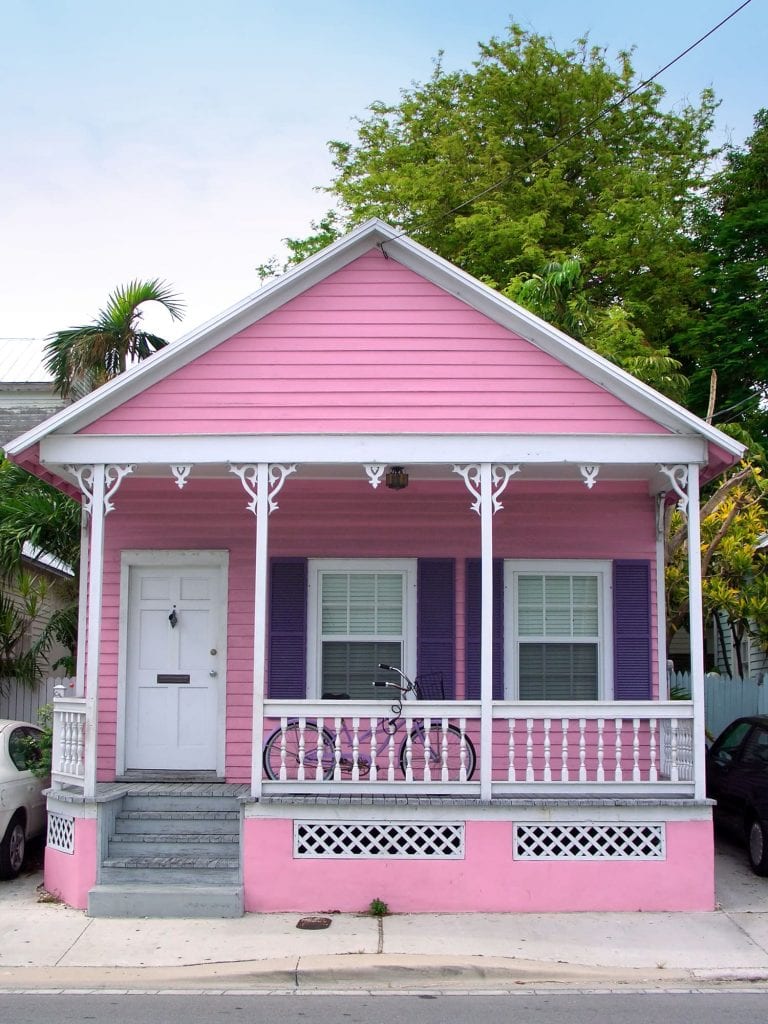
Like the Bahamian clapboard house style, many conch houses are set on wood posts or limestone, brick, and concrete piers, allowing air to circulate under the floor.
That feature helped beat the coastal heat and prevent premature wood rot and decay from water damage in an area with potential hurricanes, storms, floods, and humidity.
Other designed techniques that maximize airflow throughout the house include the long wrap-around porches, metal roofs to reflect the sunlight and the occasional inclusion of hatches for additional air circulation.
In sum, original conch houses are a practical and cost-effective form of energy-efficient home whose qualities and architectural designs are still prevalent across the Caribbean and Florida.
Conch House Characteristics
Different things make conch houses distinctive. Some of the main characteristics include:
- Low-gabled or hip roofs: The roof type in conch architecture is the low-pitched gable, typically with pressed metal, wood shingles, or composition shingles.
- Weatherboard Exterior: Horizontal weatherboard or clapboard are used as primary exterior materials.
- Double-hung sash windows: Windows are designed to increase ventilation and are convenient to clean.
- Wrap-around porches on every story: Conch houses have front porches featuring a galleried design that spans the entire width of the facade. Porches are often wrapped around the sides of the buildings and have beautifully crafted wooden balustrades and other intricate wooden decorations.
- Shutters: Conch houses have louvered vents, as well as door and window shutters, often called Bahamian shutters.
- Centrally-located main entrance: The entrance also features a transom light positioned above it.
Conch House Styles
The term “conch house” has been used to describe houses constructed in various architectural styles in Key West. However, it is most commonly associated with homes built in the charming Bahamian style. Other home styles that have influenced (or have been influenced by) conch houses include:
- Victorian
- Shotgun-Style cottages
- Caribbean Colonial Architecture
- Queen Anne
- Greek Revival
Final Words
In conclusion, the conch house is a unique housing style that showcases the rich cultural history of the Florida Keys, notably Key West. Its distinctive features, such as the sloping metal roof and wrap-around porches, make it easily recognizable.
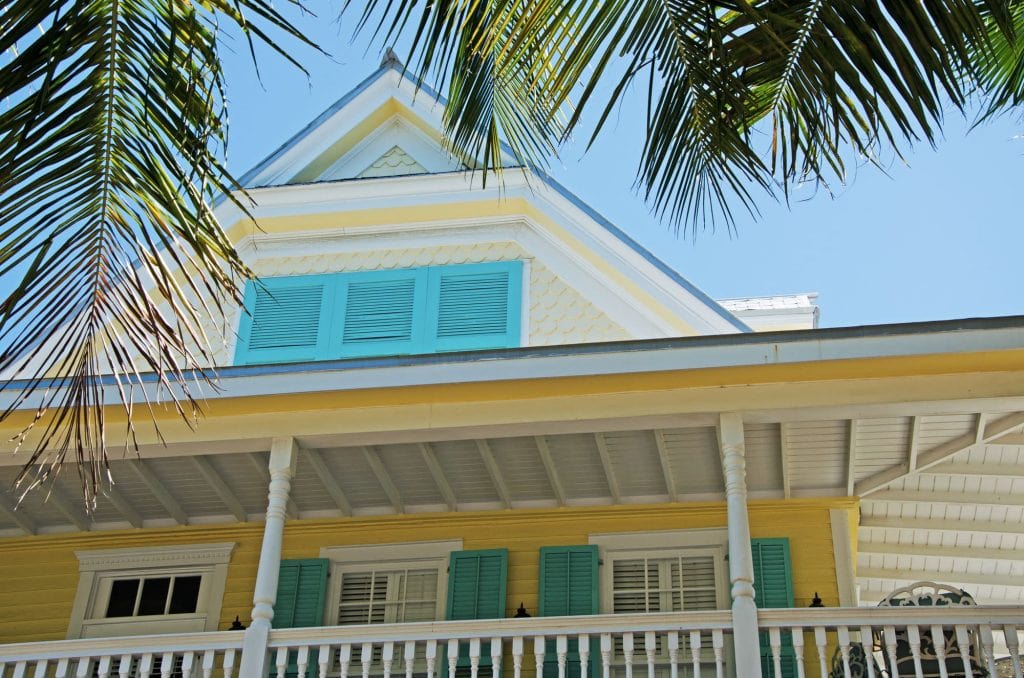
However, not just the outward appearance makes the conch house special. Its design is functional and charming, with airy rooms and clever space-saving solutions. It is a testament to the creativity and resourcefulness of the early settlers who adapted to the harsh climate and environment.
If you’re looking for a home in Key West and this housing style has caught your eye, both original conch houses and more contemporary constructions inspired by their design are often found across the market. You can do a custom home search for this architectural style on eXp Realty using our comprehensive filters.
However, if you want personalized assistance and want to see conch houses that will have a “For Sale” sign soon, a local eXp agent can lend a hand. With their expertise and deep local market knowledge, you’ll locate your dream Florida home in no time.
FAQs: Conch House
We designed our guide so you can obtain all your answers from it. However, there might be something you have yet to find an answer for. Keep reading below for some frequently asked questions about the conch house that proliferate across the Internet:
What is a conch-style house?
In simple words, the conch house style or conch house is a one-of-a-kind architectural style found across Key West and other Florida Keys, as well as certain Miami neighborhoods.
The style dates from the 19th century and was introduced by Bahamian shipbuilders who started migrating to Key West. It is characterized by its steeply pitched metal roofs, large front porches, and louvered shutters.
Where are most conch houses located in Key West?
You can see conch houses almost anywhere in Key West due to the small size of the city and its large concentration of historic constructions (nearly 3,000), but most of the best examples are in areas such as Old Town and The Meadows. There are some iconic ones you should not miss, such as:
- Mariah Brown House
- E.W.F. Stirrup House
- The Conch House on Truman Avenue that has been a B&B for years.
- Audubon House
- Oldest House in Key West
If you want to see regular residential conch houses across Key West, an excellent way to do so is by exploring the city, which is easily done by foot. Or you can take the iconic Conch Tour Train, one of the best ways to get around and peruse the local architecture. For a more guided experience, the Old Island Restoration Foundation, dedicated to preserving the city’s historically significant buildings, also offers tours.
What styles of homes are in Key West?
Key West is home to a number of housing styles, some of the most prominent ones being the Bahamian or conch house, mid-century modern homes, Mediterranean, Spanish Colonial, Victorian, and Caribbean. Homes in Key West range from grand, historic mansions to cozy seaside pastel-color cottages, providing a charming and eclectic backdrop to the island’s experiences.
]]>These cozy, circular streets offer a sense of privacy and seclusion that many homeowners find appealing. But before you sign on the dotted line to buy a new home, this guide will provide information about the ins and outs of living on a cul-de-sac so you can take a closer look at the advantages and disadvantages of this unique type of home ownership.
What Is a Cul-De-Sac?
A cul-de-sac, often called a “dead-end street,” is a residential street with a single entrance/exit, typically ending in a loop or circle. It originated in the 14th century in medieval towns; the design has become a part of 20th-century housing developments.
City records even show plans changing into cul-de-sacs for a more intimate feel in specific neighborhoods. This street type has numerous advantages, but weighing them against potential drawbacks is crucial when considering a purchase.
Pros of Buying a Home in a Cul-De-Sac
The potential of cul-de-sacs and loop streets is undeniable. There’s much to appreciate, from a sense of community to more quiet environments.
Enhanced Safety and Reduced Traffic
One of the most popular features of a cul-de-sac in residences is the obvious reduction in traffic. The unique design naturally keeps away high traffic, especially automobile traffic, ensuring that only those who live there or their visitors are likely to drive through. It leads to a safer environment, with reduced rates of traffic accidents.
As a result, children can play and roam more freely, and pets can be more safely let out. The quiet cul-de-sac offers a peaceful seclusion in a world of bustling city centers and constant movement.
Sense of Community and Neighborhood Camaraderie
Living in a cul-de-sac often creates a tight-knit community. The design of it encourages interaction, leading to more activities with the children and adults and building strong neighborhood bonds. Due to the low traffic and closeness of the homes, it’s easier to remember faces and form real life-long connections.
These relationships become stronger through a community approach to crime prevention, with neighbors looking out for each other, improving the area’s security. It’s similar to the traditional towns of the past, where everyone knew everyone, mixed with the American dream of owning a home.
Tranquility and Privacy
Beyond safety and community, culs-de-sac offer a peaceful environment. The noise is minimized with limited traffic, giving residents comfort that’s hard to find in typical straight streets or central roads.
Because these homes are usually built on plots of land, they tend to be larger than those on ordinary streets, offering bigger backyards and more space between each house. If you want room to entertain or a quiet relaxing spot, cul-de-sac homes provide an ideal setting.
Cons of Buying a Home in a Cul-De-Sac
While the charm of cul-de-sac living is undeniable, there are specific challenges prospective homeowners should be aware of. However, with every potential drawback, there are ways to mitigate, adapt, and make the best of the situation.
Limited Parking Options
With their distinctive design elements, cul-de-sacs can sometimes lead to parking constraints. The restricted space might pose challenges, especially during large gatherings or for households with multiple vehicles.
However, these challenges can be navigated with a bit of forethought. Encouraging carpooling during big events or setting up designated parking zones for guests can help.
Moreover, many cul-de-sac residents agree with neighbors about shared driveway usage, making room for everyone. The sense of community often aids in finding mutual solutions.
Potential Difficulty in Accessing Amenities and Services
With their somewhat secluded nature, cul-de-sac streets mean slightly longer commutes to main roads and commercial areas. And for those who rely on public transport, options might be limited. But it’s all about perspective!
These small inconveniences can be a trade-off for the tranquility and safety of a cul-de-sac. Plus, with the regularity of digital services, groceries or other essentials can be delivered right to your doorstep.
Planning your errands can also reduce frequent trips to the city center.
Higher Costs and Limited Home Variety
Due to the high demand for cul-de-sac properties, prices can sometimes be steeper. Built around the same time, many of these homes’ architectural diversity might be limited, with fewer customization options.
But here’s the silver lining: owning a property in a sought-after location can be a wise long-term investment, appreciating over time.
For those craving a unique touch to their homes, interior renovations and garden landscaping can provide ample opportunities to express individuality and style, making the home truly yours.
Factors To Consider When Deciding To Buy a Home in a Cul-De-Sac
Deciding to purchase a home in a cul-de-sac requires introspection, foresight, and pragmatic reasoning. While offering many advantages, the unique street patterns also come with their own considerations.
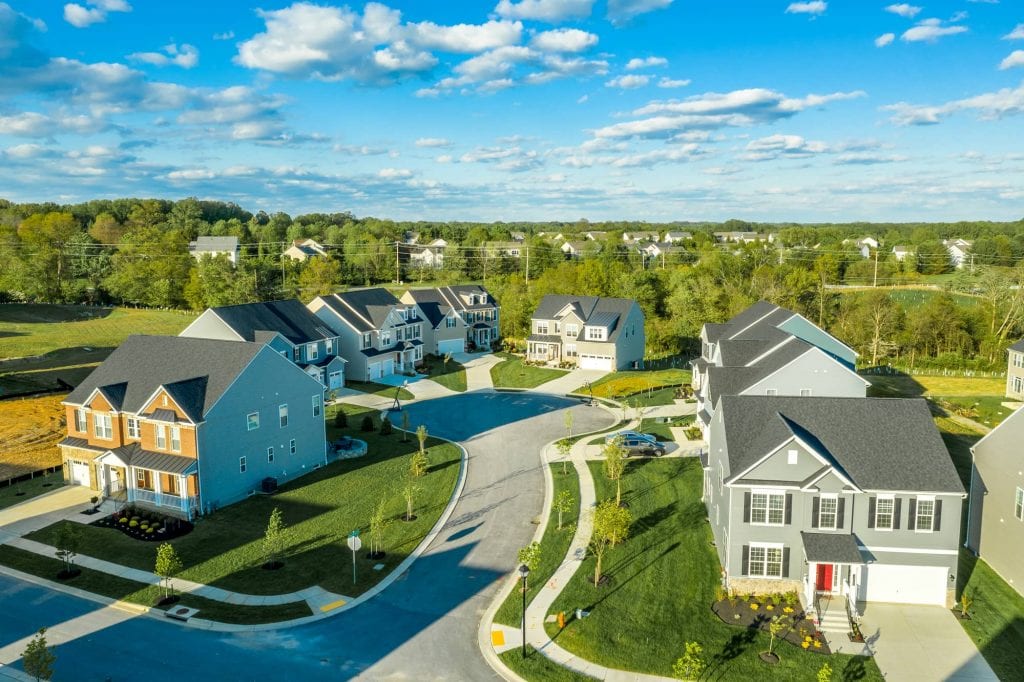
Lifestyle and Personal Preferences
The serene ambiance of a cul-de-sac can be the epitome of a tranquil living experience, but it’s essential to gauge if it aligns with your personal preferences. While some thrive in the stillness of a secluded environment, others might crave the hustle and bustle of city centers. Moreover, it’s essential to contemplate future needs.
Could there be potential lifestyle changes on the horizon? In addition to the family, a new job, or even evolving social preferences? It’s worth weighing the allure of a quiet cul-de-sac against these foreseeable changes.
Commute and Access to Amenities
One of the compelling design elements of cul-de-sac streets is their distance from major thoroughfares. While this ensures reduced traffic volumes, it might mean a slightly elongated commute. Evaluating how this impacts daily routines, especially in American cities where drive times can be substantial, is critical.
Additionally, while the seclusion is lovely, how far are you from essential services? Consider the proximity of schools, shopping centers, medical facilities, and recreational areas. Sometimes, the charm of a quiet cul-de-sac will offset the convenience of being closer to urban networks.
Parking and Space Requirements
Parking can be a significant consideration, especially in households with multiple vehicles. Assess your parking needs, especially if you foresee a vehicle increase in the coming years.
Guest parking, especially during social gatherings, can also be a determining factor. And remember storage! While often boasting larger lots, cul-de-sac homes might have limited storage options, especially if no garage or shed exists.
Resale Value and Investment Potential
Real estate is as much an emotional decision as a financial one. Considering the resale value of a cul-de-sac property is crucial. Such properties often see appreciable growth in value due to their demand.
However, market trends, the overall health of the economy, and local factors like upcoming infrastructure projects can play a role. Consulting with an expert real estate agent can provide insights into the potential return on investment.
Key Takeaways
Buying a home in a cul-de-sac presents a unique set of advantages and challenges deeply rooted in its distinct design elements and neighborhood dynamics.
Every prospective homeowner should weigh these factors against their lifestyle preferences, current and future needs, and financial considerations. While a cul-de-sac might be the epitome of suburban dreams for some, it might not align with the aspirations of others. It’s all about personal evaluation.
Like any home-buying decision, living in a cul-de-sac blends heart and mind. To ensure you’re making the right choice, delve deeper, understand your priorities, and always consult an expert to guide you through the intricate world of real estate. Are you looking to explore more properties or need expert guidance?
Search for properties on eXp Realty or contact a local eXp Realty agent who can tailor their advice to your unique circumstances for your future home on a cul-de-sac.
FAQs: Cul-De-Sac
As urban areas grow, many homebuyers think about residential streets and their potential impact on their family’s lifestyle. Let’s address some common questions about the cul-de-sac.
Is cul-de-sac good or bad?
A cul-de-sac has both pros and cons. Pros include increased safer traffic environments, a sense of community, and peacefulness. Cons may involve limited parking options, potentially longer commutes, and higher housing costs. The “good” or “bad” is subjective and depends on what you are looking for.
What is the difference between a circle and a cul-de-sac?
A circle is a roundabout or a circular road pattern used to manage traffic flow. A cul-de-sac is a dead-end street with a single entry/exit point, usually forming a loop or circle at its end. It is primarily used in residential areas for limited traffic.
What are the differences between a cul-de-sac development and a traditional grid development in suburbs?
Cul-de-sac developments prioritize safety and tranquility by minimizing traffic. Grid developments, typical of 19th-century gridiron patterns, provide direct connections between streets, enhancing accessibility and city center connectivity but can have higher traffic volumes.
Would a house on a main road have better Feng Shui than one in a cul-de-sac?
Feng Shui principles often favor houses with free-flowing energy. While main roads signify active energy, they also denote fast, aggressive energy. Cul-de-sacs, conversely, may risk stagnant energy due to their closed nature. However, Feng Shui is complex; specific house placements and design elements also play crucial roles.
What is a cul-de-sac?
A cul-de-sac is a dead-end street with only one entrance/exit, often forming a loop or circular shape at its end. This street pattern is primarily designed for residential areas, providing lowest traffic, enhancing safety, and fostering a community atmosphere.
]]>Not only do natural slate roofs offer a timeless aesthetic appeal, but they also have exceptional durability when properly installed and cared for. If you’re considering a new roofing material, a slate roof may just be the perfect choice for both its beauty and longevity. Keep reading our guide to know more about this roofing option if you’re considering roof replacement.
What Is a Slate Roof?
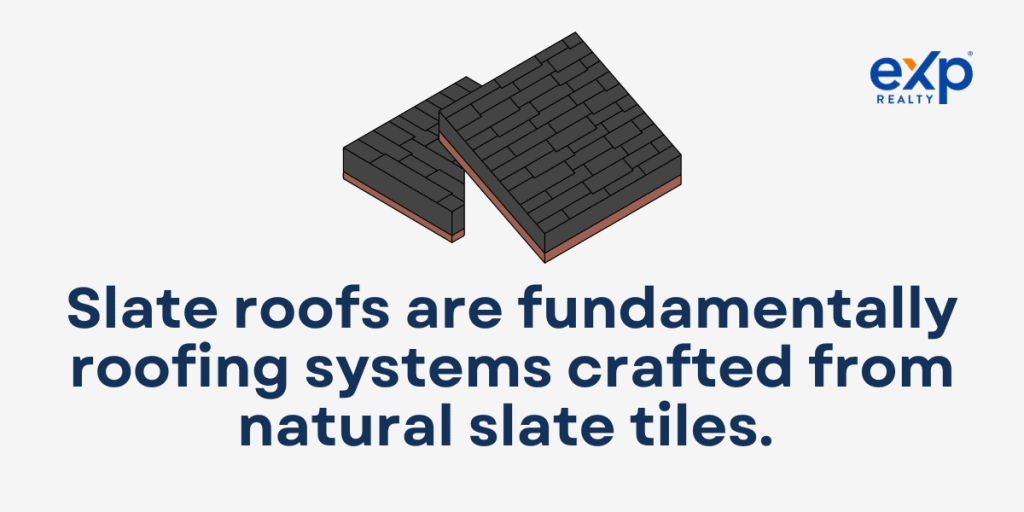
Slate roofs are fundamentally roofing systems crafted from natural slate tiles. These tiles are sliced from real slate stone and celebrated for their robustness, eye-catching appeal, and impressively prolonged lifespan.
Originating from quarries and having been used for centuries, traditional slate is rooted in history as a roofing material. This natural material has adorned historic buildings, government structures, and residential homes, standing the test of time and elements. Its resilience is a testament to its natural beauty and strength.
The appeal of a slate roof doesn’t just lie in its look; the benefits are multifold. When you hear the term ‘roof over one’s head,’ it evokes a sense of protection and permanence. And when that roofing is slate, those feelings are only amplified, given its long-standing reputation in the roofing world.
The Advantages of Using Slate as a Roofing Material
There are hundreds of types of roofing materials to pick from. Several attributes render slate roofs a preferred pick for homeowners and builders aiming to blend functionality and visual charm. Below are some of the advantages of using slate as a roofing material:
Durability and Longevity
Slate roofs can last up to 150 years, making them perfect for homeowners looking for semi-permanent roofing material. While slate roofs can last for decades with minimal issues, proper maintenance is crucial. Regular roofing professional checks can help identify problems like broken tiles or water damage, ensuring the roof remains in top condition.
Fire Resistance
Unlike wood shingles and other roofing options, slate does not ignite. Consequently, the slate does not burn with an increase in temperature. This feature is reassuring to homeowners who prioritize safety for their homes. However, at certain extreme temperatures, the slate might melt.
Resistance to Weather Elements
Slate is a natural material that contains stable mineral compounds within its core. While severe weather might affect the color of the slate after several decades, the slate remains relatively unchanged by damage from weather. This property is because the slate lacks reactive compounds that would interact with different weather conditions.
Aesthetics and Architectural Appeal
Beyond its obvious beauty, the real allure of slate lies in its origin. Slate is a natural product extracted directly from the earth, making each tile unique. Unlike synthetic materials like asphalt shingles, every slate tile carries a piece of earth’s history, exhibiting varied patterns, textures, and colors. This variety ensures that no two slate roofs are identical, each with a unique charm.
Variety
Roofing slates come in types ranging from soft slate to hard slate, each having its specific set of features. For instance, while soft slate roofs might last up to 125 years, hard slate can stand firm for over 200 years, making them durable roofing materials.
The color palette of slate tiles is vast. From the classic gray and black slate to the rarer hues of purple slate and green, slate roofs can complement various architectural styles, from modern minimalist to classic Victorian.
Choosing the Right Professional
With a significant investment like a natural slate roof, it’s imperative to have the right team for installation and maintenance. Selecting a qualified roofing contractor is essential. A professional contractor will ensure proper installation and advise on the best slate type suitable for a specific region or architectural style.
Whether it’s understanding the nuances of American slate or the unique characteristics of Buckingham slate, a professional real estate agent can make a significant difference.
Moreover, having a dedicated roofing company for regular maintenance ensures that minor issues don’t escalate into major repairs. From simple, real slate roof cleaning to handling more intricate tasks like slate roof repair, having an expert by your side ensures the longevity and beauty of the roof.
Factors To Consider When Choosing Slate for a Roof
Selecting the perfect roofing material is a paramount decision in construction or renovation. With slate, homeowners are investing in both aesthetic elegance and unmatched durability. A real estate agent can help you go over all considerations.
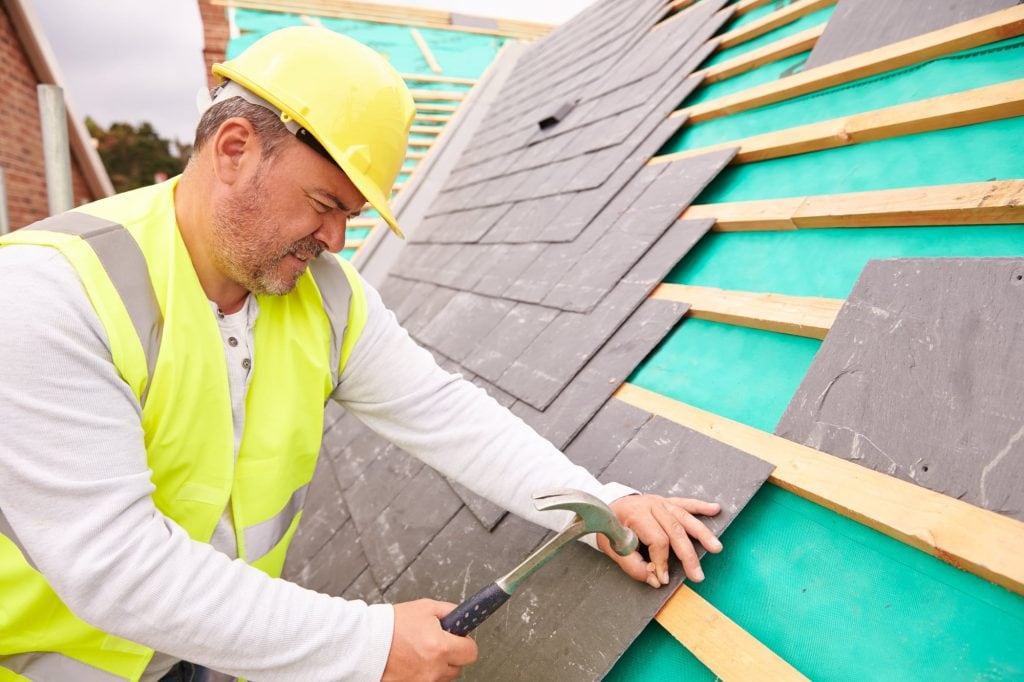
Like every high-end product, the choice of a natural slate roof requires thorough contemplation of several factors. Here’s what you need to consider:
Structural Requirements
The robustness of slate shingles is undeniable, but its strength also translates to weight. It’s imperative to recognize that slate tiles are considerably weightier than other roofing materials, like asphalt shingles.
Before committing, homeowners should consult with a structural engineer to ensure that the existing or planned roof structure can bear the weight of a slate roof. This evaluation might mean reinforcing the roof deck or even considering the foundational strength of the building.
Maintenance and Repairs
While slate roofs can last for decades or even centuries, they are only partially devoid of maintenance requirements. Slate tiles can occasionally break or become loose due to environmental factors or foot traffic.
Opting for slate means committing to periodic inspections and potential minor repairs. Collaborating with a roofing professional or a slate roof specialist ensures that the beauty and functionality of your roof remain uncompromised over the years.
Cost Considerations
Understanding the cost of slate is crucial for homeowners considering this roofing option. The average cost of installing a slate roof can vary depending on several factors, including the type of slate chosen, roof sizes, and labor costs. Much of the expenditure is in the material costs, given that genuine slate tiles are a premium product.
High quality often comes with a price tag to match. The cost of slate roofing might be higher than other materials. Factors like slate type, whether it’s American slate or coveted Buckingham slate, and the size and thickness of the tiles play a role in the overall cost.
It’s also crucial to factor in labor costs since installing a slate requires specialized skills. However, when weighing the cost, one should consider the potential long-term savings due to its longevity and minimal maintenance requirements.
Color and Texture Options
One of the many allures of slate roofing is its vast spectrum of colors and textures. From the classic elegance of the Vermont unfading gray color slate to the uniqueness of purple slate or textural slate roofs, a palette matches every architectural style and personal preference.
This variety ensures homeowners find a slate that resonates with their home’s character and aesthetic inclinations.
Size and Thickness Considerations
Slate tiles come in many sizes and thicknesses, each lending a distinctive appearance and feel to the roof. While larger tiles offer a more modern and seamless look, smaller tiles can exude a more traditional vibe.
Similarly, the thickness can impact the roof’s look and weight. Consulting with a roofing contractor to find the right balance between aesthetics and structural requirements is essential. Specialized tools such as a slate cutter can also contribute to increased costs.
It’s also essential to consider the weight of a slate roof. Since slate is a natural stone, it’s considerably heavier than roofing materials like asphalt shingle roofs. This weight means homeowners must ensure they can bear the added weight before a slate roof installation.
Lifespan and Warranty
Given the significant investment that a slate roof entails, homeowners should consider the lifespan of the slate they’re opting for. As mentioned earlier, longevity can vary between soft slate roofs and hard slate varieties.
Furthermore, it’s beneficial to understand the roof warranty provided by manufacturers. Companies might offer a lifetime warranty, but it’s crucial to understand the terms and conditions attached.
Environmental and Ethical Considerations
As a natural product, slate mining can have environmental implications. Prospective buyers want to research the sourcing practices of slate suppliers.
Additionally, some slate options, like synthetic slate roofs, offer an environmentally-friendly alternative that mimics the look and feel of natural slate roofing without the associated ecological concerns.
Slate Roofs vs. Other Roofing Materials
A house’s roof is indispensable as a protective shield against the elements and in defining the home’s aesthetic appeal.
Given the wide range of roofing materials available, homeowners often find themselves pondering the pros and cons of each. Let’s delve into how slate roofs compare with other popular roofing materials.
Slate Roof vs. Asphalt Shingles
Asphalt Shingle Roof
- Average Cost: Asphalt shingles are typically more affordable than slate, making them popular for many homeowners. The average cost per square foot for materials and installation can be lower than slate.
- Lifespan: While asphalt shingles have a decent lifespan, usually 15 to 30 years, they don’t compare to the longevity of slate.
- Maintenance Issues: Regular maintenance is required, with the potential for costly repairs due to environmental wear and tear.
- Aesthetics: Offers a range of colors and styles but lacks slate’s unique and timeless beauty.
Slate Roof
- Natural Beauty: The aesthetic of natural slate roofing is unmatched. The tiles often change hue over time, enhancing their appeal.
- Durability: A well-maintained slate roof can last over a century. In contrast, asphalt usually requires replacement slates within 30 years (relatively safe from inclement weather).
- Environmental Impact: Slate is a natural product, making it more environmentally friendly than the manufacturing process of asphalt shingles.
- Average Cost: The initial investment for a slate roof can be higher, but the long-term benefits often outweigh the initial costs.
Slate Roof vs. Metal Roof
Metal Roof
- Lifespan: Metal roofs have a respectable longevity, often lasting 40 to 70 years, depending on the type of metal used, such as galvanized steel or stainless steel.
- Durability: They are resistant to hail damage, fire, and rot. However, they might dent upon impact.
- Maintenance: Metal roofs require minimal maintenance, similar to slate.
- Cost: While generally more affordable than slate, metal roofing can be pricier than other materials like asphalt.
Slate Roof
- Weight: Slate tiles are considerably heavier than metal sheets, making structural considerations vital.
- Aesthetic Versatility: Slate roof tiles offer various colors and textures, lending a classic touch to homes.
- Thermal Performance: Slate roofs offer excellent insulation properties, potentially reducing heating and cooling costs.
- Environmental Impact: Slate is a natural stone with a lower carbon footprint than metal roofs’ energy-intensive production.
Comparing Other Roofing Materials
- Slate Roof Tiles: Like slate, roofing tile is heavy and requires a sturdy structure. However, while tiles are durable, they must match the slate’s longevity or timeless aesthetic.
- Flat Roof: Primarily made of tar and gravel, rubber, or other synthetic materials, flat roofs offer a modern look. They generally have a shorter lifespan and might not provide the same insulation benefits as slate.
- Wooden Shingles: Wooden shingles require regular maintenance to protect against rot and pests. Their lifespan is generally shorter than slate, and they can be susceptible to water damage and fires.
Key Takeaways
Few can match slate’s elegance, durability, and time-tested reputation regarding roofing materials. Sign up to get alerts of new property listings with slate roofing when they come on the market. Here’s a quick recap of what we’ve discussed:
- Natural Material: Slate is a natural material offering an unparalleled aesthetic that blends effortlessly with various architectural styles, from historic to modern.
- Durability: A well-maintained slate roof can last over a century, outperforming many other roofing materials in terms of lifespan and resilience.
- Versatility: With its variety of colors and finishes, slate can match the unique character of any home.
- Environmental Impact: Slate roofs are an eco-friendly natural stone, presenting a green choice for environmentally-conscious homeowners.
- Comparison: While other roofing options like asphalt shingles and metal roofs have their merits, slate roofs often emerge as the top choice when considering longevity, beauty, and environmental benefits.
Slate is worth exploring for homeowners looking to invest in an entire roof that protects their home and adds to its charm. Its enduring appeal has stood the test of time, making it a classic choice for those with discerning taste.
Contact a local eXp agent for more insights and professional guidance on roofing materials and installations. You can also search for properties at eXp Realty and filter for this type of roofing for investing or inspiration.
FAQs: Slate Roof
Roofing decisions are significant investments, and it’s natural to have questions. Let’s address some commonly asked queries about slate roofs:
Is a slate roof a good roof?
Absolutely! Slate roofs offer an unparalleled combination of aesthetic beauty, durability, and minimal maintenance requirements, making them one of the top choices for homeowners around the globe.
How long do slate roofs last?
Slate roofs can last over a century, with some enduring 150 years or more.
]]>Whether you’re relocating for a job, downsizing, or simply seeking a change in scenery, we’ll discuss the most effective ways to put your home on the market, ensuring you get the best return on your investment.
Hiring a Traditional Real Estate Agent
A real estate agent is more than someone who puts up the “For Sale” sign on your lawn. They’re a vault of industry knowledge, a negotiator, and often a comforting presence in an otherwise stressful process.
An agent provides invaluable insights into market trends, helping you set a competitive price for your property. Their hyperlocal expertise ensures your home isn’t underpriced or overpriced in its current market.

The selling experience is visual. An experienced agent often brings a network of professionals, including professional stagers and photographers, ensuring your home looks its best in online listings and open houses.
From crafting the perfect purchase agreement to understanding the nuances of closing costs and agent commissions, an agent’s hands-on expertise is unmatched.
Benefits
The benefits of employing a real estate agent during the selling process are manifold:
- Market Analysis and Knowledge: Through comparative market analysis, agents can identify the median price and price range of homes for sale in your area, ensuring you list your home at a fair market value. Their experience and training allow them to spot potential challenges before they arise, ensuring a smoother selling process.
- Guided Selling Experience: From minor repairs to adding a fresh coat of paint, agents provide suggestions to enhance the appeal of your home to prospective buyers.
- Negotiation Skills: Savvy agents have a track record of successfully negotiating sale prices, ensuring you get the best deal possible.
- Network Expansion: Their broad network of professionals, from mortgage lenders to inspectors, makes sure every aspect of your sale transaction is in good hands.
- Legal Compliance: Real estate agents are well-versed in local regulations, ensuring the entire process, from listing to the closing table, is compliant with legal standards.
Potential Drawbacks
However, there are certain considerations homeowners should be aware of:
- Commission Fees: One of the most common concerns for homeowners is the commission fees associated with hiring an agent. Typically ranging from 4% to 6% of the home’s selling price, this fee can quickly add up, especially in higher-end markets.
- Potential for Misaligned Interests: While most agents genuinely strive to get the best deal for their clients, some may prioritize a quick sale over getting the highest possible price.
- Loss of Personal Control: Hiring an agent means entrusting them with major decisions about the marketing and sale of your home. This can feel restricting for homeowners who want more control over the sales process.
- Potential Delays: Relying on an agent’s schedule might mean waiting for their availability for showings, open houses, or meetings. If they’re managing multiple properties, it could cause potential delays in responding to offers.
- No Guarantee of Sale: Even with an agent’s expertise, the house is not guaranteed to sell within a desired timeframe or for the anticipated price. Market conditions, property specifics, or pricing strategy can all influence the outcome.
The For Sale By Owner (FSBO) Option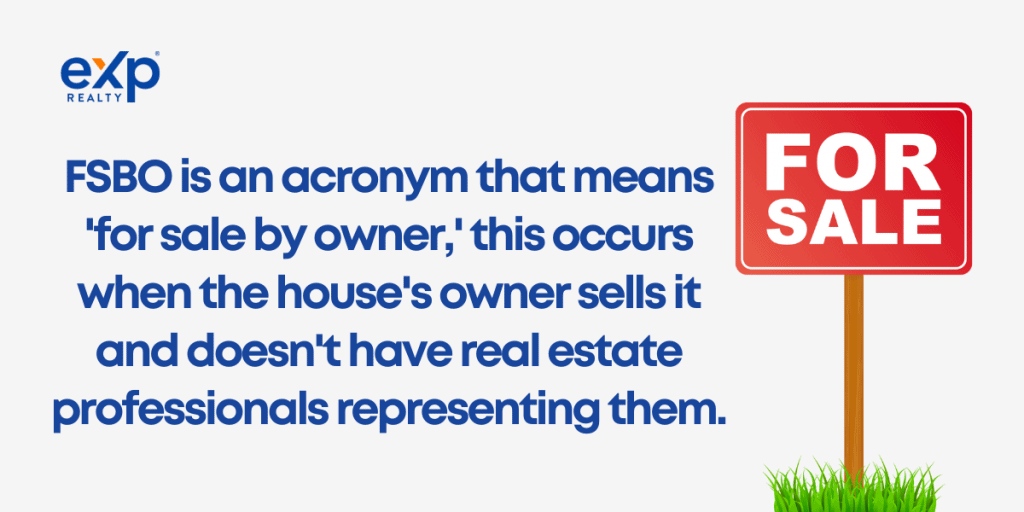
For Sale By Owner (FSBO), as the name suggests, is a homeowner-driven approach where the property owner assumes the role traditionally held by a real estate agent. Instead of paying commission fees to an agent, homeowners shoulder responsibilities ranging from advertising the property to finalizing the paperwork.
Sellers take the initiative to showcase their homes through online listing services, yard signs, or even leveraging local community boards. They also personally schedule and oversee property visits. Additionally, homeowners manage the required documentation, ensuring it complies with local and state regulations.
Benefits
Opting for an FSBO approach presents several distinct advantages:
- Cost Savings: The most compelling reason homeowners gravitate towards FSBO is the potential savings. By sidestepping agent commissions, sellers might retain a larger chunk of the sale price.
- Full Control: Sellers have complete authority over the entire process, from deciding the list price to choosing which offer to accept.
- Direct Communication: There’s no need for a middle-man. Sellers directly interact with prospective buyers, which can sometimes simplify negotiations and agreements.
- Flexibility in Showings: Without coordinating with an agent’s schedule, homeowners can plan property showings at times that are convenient for them.
- Custom Marketing Approach: FSBO sellers can craft a unique marketing approach that best showcases their property, whether focusing on social media, local advertising, or hosting community open houses.
- Potential for Unique Selling Propositions (USPs): As the homeowner knows the property best, they might highlight USPs that an agent might overlook. From a custom-built treehouse in the backyard to the history of the century-old oak tree out front, homeowners can use intimate knowledge of their property to appeal to specific buyer interests.
Challenges
However, as with any hands-on endeavor, FSBO comes with its set of challenges:
- Expertise Deficit: Real estate transactions can be intricate. Without a solid grasp of the current market conditions, FSBO sellers may inadvertently underprice or overprice their homes. Moreover, navigating the closing process, understanding contract details, and being aware of the required disclosures can be daunting.
- Limited Marketing Reach: Without a real estate professional’s extensive network and tools, sellers might find their marketing efforts unrestricted, potentially limiting the pool of qualified buyers.
- Time-Intensive: The selling process is multifaceted. From fielding phone calls to coordinating showings and handling offers, selling a home is a full-time job. For many homeowners, the time commitment can be overwhelming.
- Negotiation Hurdles: Without an intermediary, negotiations can sometimes become personal or emotionally charged, potentially complicating the sale process.
Sell Your Home in Online Real Estate Marketplaces
The digitization of the real estate sector has given rise to online marketplaces, where homeowners can list and sell their properties with just a few clicks. Platforms like eXp, Zillow, Redfin, and Rocket Homes have become household names, offering a seamless interface for both buyers and sellers.
Benefits
Here are some of the many benefits of selling on digital platforms:
- Wide Exposure: These platforms have vast user bases. With millions of monthly visitors, listings on these sites can quickly gain visibility, reaching potential buyers from various demographics and geographical locations.
- Direct Communication: Sellers and potential buyers can interact directly through built-in messaging features, leading to transparent and streamlined communication.
- Data and Insights: Online marketplaces offer valuable data analytics and insights, from neighborhood price trends to estimated property values. This data can aid sellers in pricing their homes competitively.
- User-Friendly Interfaces: The design of these platforms often prioritizes user experience. Easy navigation, interactive maps, and comprehensive filters can enhance property visibility and appeal to potential buyers.
- Cost-Efficiency: Several platforms offer reduced commission fees or flat-rate service fees, potentially reducing the overall cost of selling a home.
Potential Drawbacks
However, as with any method, there are potential challenges you need to be aware of:
- Increased Competition: The ease of listing on these platforms means numerous properties are up for grabs, leading to fierce competition. A unique selling proposition or aggressive pricing strategy might be necessary to stand out.
- Limited Control: Some platforms might dictate the presentation or marketing aspects of the listing, leaving homeowners with restricted control over how their property is portrayed.
- Reliance on Platform Algorithms: The visibility of a listing often depends on the platform’s algorithms, which determine which properties get prominently displayed. Changes to these algorithms can impact the reach of a listing, potentially reducing its exposure.
- Potential for Scams or Unserious Buyers: With broader exposure comes the risk of attracting individuals who aren’t serious about purchasing or, worse, are attempting scams.
Sell Your Home in Real Estate Auctions
Real estate auctions are events where properties are sold to the highest bidder, usually after a quick and dynamic bidding process. Real estate companies, independent auction houses, or online platforms can organize these auctions.
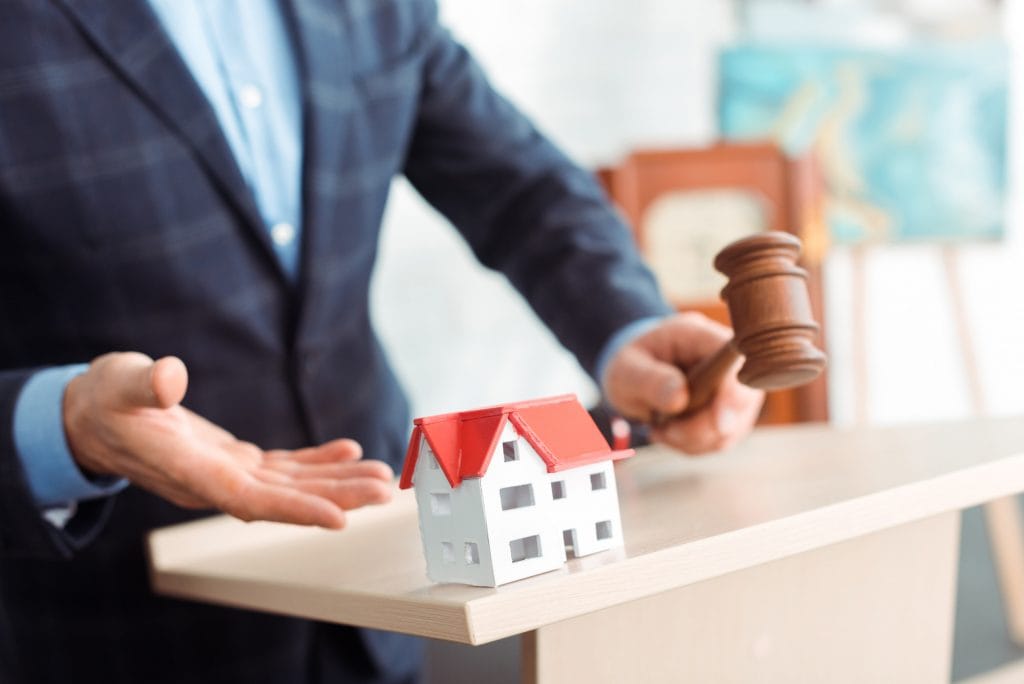
There are different types of auctions in the real estate world. Traditional live auctions involve bidders being physically present at an auction house or the property’s location. An auctioneer leads the proceedings, and bidders raise their paddles or call out their bids.
Moreover, online platforms allow bidders to participate anywhere. Websites like Auction.com have popularized this format, offering residential and commercial properties.
Benefits
Real estate auctions can offer several distinct advantages:
- Quick Sales: Auctions usually have a set date and time, ensuring that properties get sold promptly, a boon for sellers looking for a fast sale. This can be advantageous for those needing to relocate quickly, settle an estate, or liquidate assets.
- Highly Competitive: The dynamic nature of auctions can sometimes drive the price higher, especially if multiple parties are interested in a property.
- Transparent Process: The open bidding process ensures transparency, with every participant aware of the ongoing bids. This transparency can reassure sellers that they have achieved a fair price.
- Pre-Qualified Buyers: Most auction houses require bidders to pre-qualify for an auction, ensuring that only serious buyers attend. This can minimize the chance of sales falling through due to financing issues or cold feet.
Potential Drawbacks
While auctions can offer advantages, they also come with inherent risks:
- Uncertain Sale Prices: While bidding wars can increase prices, properties will likely sell below the desired price, especially with limited interest.
- Time Constraints: The speed of auctions can be both a blessing and a curse. While they can expedite sales, they also give sellers less time to market the property and generate interest.
- Upfront Costs: Sellers might have to bear some upfront costs, including listing fees or marketing expenses, with no sale guarantee.
Consider Home Cash Buyers
Home cash buyers offer to purchase properties outright without needing traditional financing or mortgage loans. While this method may seem unconventional, it’s an attractive option for homeowners looking for speed and convenience.
These buyers might be individuals, real estate investment firms, or specialized companies that often acquire various types of properties, including family homes, apartments, or rental properties, for their diverse investment portfolios.
Benefits
This method comes with several advantages:
- Swift Transactions: Since cash buyers don’t need to worry about traditional mortgage payments, approvals, or exploring loan options, these sales can close in a week.
- Simplified Sales Process: Selling to a cash buyer usually means fewer steps. Homeowners won’t have to worry about staging their homes for multiple showings or dealing with potential buyers falling through due to financing issues.
- As-Is Sales: Many cash buyers purchase homes in their current condition, which can be particularly beneficial for homeowners with properties that require major repairs.
- No Agent Commissions: Many cash deals occur without real estate agents, so homeowners might save on commission fees.
Potential Risks
Despite the benefits, cash buyers have certain risks:
- Potential for Lower Offers: Cash buyers often look for deals that allow them to earn a return on their investment, which can mean they present offers below the home’s fair market value or a listing price.
- Potential for Scams: While many cash buyers operate with integrity, as with any real estate transaction, there is a risk of scams. It’s crucial to research any cash-buying firm or individual, checking for reviews, past transaction history, and any red flags.
- Lack of Emotional Attachment: Unlike traditional buyers who might purchase their dream home, cash buyers are typically more detached and purely financially motivated. This can lead to more rigid negotiations. Additionally, sellers might miss the emotional satisfaction of knowing their home is going to a family or individual who cherishes it.
Lease Options and Rent-To-Own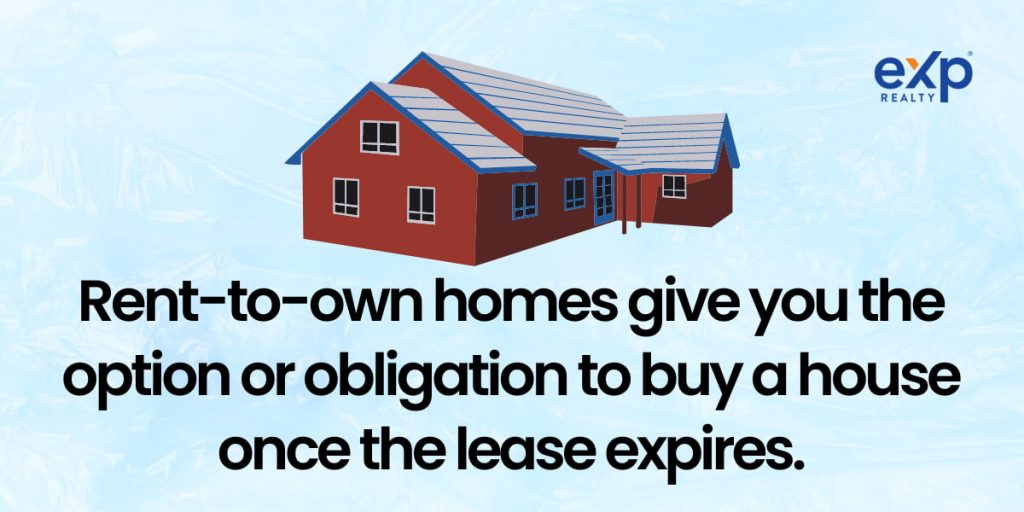
Lease options and rent-to-own are alternative real estate strategies that mutually benefit buyers and sellers. At their core, both involve a tenant or buyer leasing a property with the potential to purchase it later. The difference typically lies in the specific terms and conditions set by the agreement.
A lease option is typically a two-part agreement. The tenant can lease a property with the choice to buy it later. They pay an option fee upfront, and a portion of their monthly rent might be credited toward the purchase price if they choose to buy. They aren’t obligated to buy but still have the option if they choose to.
Meanwhile, in a rent-to-own scenario, the tenant agrees to rent the property for a set period, after which they must either purchase the property or forfeit any accumulated rent premiums. This model is more binding than the lease option and typically involves a more structured path to homeownership.
Benefits
Lease options and rent-to-own agreements have a set of distinctive benefits that can make them an enticing choice for both sellers and potential homeowners.
- Attracting Potential Buyers: These methods can appeal to individuals who might not qualify for traditional mortgages due to credit issues but are working towards improving their financial situation.
- Generating Rental Income: The homeowner can benefit from consistent rental payments while the prospective buyer decides or prepares to purchase.
- Securing Higher Sale Prices: Given the unique arrangement, sellers might often negotiate a slightly higher than average sales price, especially if the housing market trends are uncertain.
- Decreased Vacancy: Homes can remain occupied while prospective buyers work towards improving their financial standing, reducing the risks and costs associated with vacant properties.
Potential Challenges
However, like all real estate strategies, lease options and rent-to-own agreements have challenges:
- Complex Legalities: Lease options and rent-to-own agreements require detailed contracts that specify the terms, such as the potential purchase price, duration of the lease, and how much rent goes toward the purchase. It’s essential to work with skilled professionals to ensure all details are adequately addressed.
- Risk to Sellers: If property values rise significantly during the lease term, homeowners might miss out on selling at a higher price in a competitive market.
- Risk to Buyers: On the flip side, if property values decline, buyers might be obligated to purchase a property worth less than they agreed to pay.
- Maintenance Responsibilities: Depending on the agreement, maintenance responsibilities might fall on the tenant since they intend to buy. This can be a gray area and should be explicitly outlined in the contract.
- Default Concerns: If a tenant-buyer defaults or chooses not to buy, the seller might have to restart the selling process, which can be time-consuming and costly.
Alternative Selling Strategies
In an ever-evolving real estate market, sellers continuously seek innovative ways to stand out and gain the attention of potential buyers. The journey from listing a house to sealing the deal involves more than just determining a list price or uploading a few professional photos online.
With the advancement of technology and the changing preferences of prospective buyers, alternative selling strategies have emerged, offering a competitive edge. Let’s explore some of these unique strategies.
Home Staging
Home staging involves arranging furniture and decor to showcase the property’s best features and make it appealing to a broad audience. It’s always a good idea to remove personal belongings like family photos when staging the home, ensuring prospective buyers can visualize themselves in the space.
Some of its benefits include:
- Elevated Marketing: Staged homes often photograph better, resulting in more attractive online listings, the primary way potential buyers view the property initially.
- Increased Buyer Interest: With furniture and decor in place, buyers can better understand the scale and potential of spaces, helping them visualize their life in the property.
- Higher Sale Prices: A beautifully staged home can leave a lasting impression, often leading buyers to perceive its value as higher and, thus, be willing to pay a premium.
- Quicker Sales: Homes that have undergone professional staging often spend less time on the market, as they can capture buyers’ interests more efficiently.
Virtual Tours
Virtual tours have emerged as a groundbreaking way for buyers to explore homes from the comfort of their screens. These digital walkthroughs offer 360-degree views using 3D technology, allowing users to navigate through every nook and cranny of a property.

Among its many benefits include:
- Extended Reach: Virtual tours are accessible to anyone with an internet connection, allowing potential buyers, even from different states or countries, to explore homes they’re interested in.
- Convenience: Buyers can view properties at their own pace and revisit them as often as possible without scheduling multiple viewings.
- Engaging Presentations: Advanced virtual tours can offer interactive floor plans, integrated details about the property type, and even area highlights, enhancing the buyer’s experience.
- Modernized Listings: Properties with virtual tours stand out in online listings, often gaining more views and generating increased interest.
- Safety and Continuity: Especially pertinent in times when physical viewings may be challenging or limited (like the Coronavirus pandemic), virtual tours ensure that properties can still be showcased in all their glory.
Evaluating Your Options
Your home is not just a place where memories are made; it’s a significant financial asset. Therefore, making informed decisions is crucial when putting it on the market. Here’s how you can assess and choose the right selling option tailored to your situation:
Time Constraints
If you need a swift sale, direct home cash buyers or houses for cash might be your best bet, as they can finalize the selling process within a few days. On the other hand, if you have time and wish to maximize profits, selling through a real estate agent or FSBO could yield higher returns, albeit taking longer.
Desired Sale Price
Your desired sale price can greatly influence your choice. Listing agents can provide a comparative market analysis to help price competitively. On the contrary, cash home buyers might offer below the market price if you’re aiming for a quick sale.
Personal Preferences
Some homeowners prefer direct control, leading them to opt for FSBO. However, others might feel more comfortable having a professional oversee the entire process, prompting them to hire an experienced agent.
Step-by-Step Guide to Making Your Decision
Here is a list of things to do to help you make an informed decision:
- Research: Begin by understanding each selling strategy’s pros and cons. Explore recent data, success stories, and potential pitfalls.
- Consult Professionals: Even if you’re leaning towards FSBO or online platforms, consulting with a real estate agent or an industry expert can offer invaluable insights.
- Assess Your Home: Get a professional home valuation or appraisal. This will give you a realistic starting point when considering sale prices across different strategies.
- Define Your Priorities: List what’s most important to you—be it speed, profit, ease, or control over the process.
- Simulate Scenarios: Based on your home’s valuation, consider potential scenarios. For example, if you choose an agent, factor in commission fees to see your potential net profit.
- Seek Feedback: Talk to friends, family, or neighbors who have recently sold homes. Their firsthand experiences can shed light on unforeseen challenges or advantages.
- Decide and Prepare: Once you’ve made a decision, prepare accordingly. Whether staging your home, setting up a virtual tour, or researching legal documentation for FSBO, ensure you’re fully ready for the next steps.
Key Takeaways
Selling a home is a monumental decision that requires careful planning and consideration. This guide explored various selling options, from traditional real estate agents to alternative selling strategies.
Moreover, by embracing forward-thinking strategies such as home staging and virtual tours, sellers can enhance their property’s appeal and amplify their reach in this digital age.
It’s important to remember that there’s no one-size-fits-all approach. Each method of selling comes with its advantages and challenges. Consequently, the ideal choice depends on your preferences and market insights.
As you embark on this journey, remember the importance of conducting thorough research, understanding the real estate market’s intricacies, and seeking professional guidance. If you’re ready to dive deeper, explore properties, or contact a local eXp agent to guide you every step of the way.
FAQs: Sell My House
Here are our answers to some of the most commonly asked questions regarding selling your house.
What is the most profitable way to sell my house?
The most profitable method typically involves selling through a real estate agent or going the FSBO route, ensuring the house is pristine and priced competitively based on a comparative market analysis.
Where is the best place to sell your house?
The best place often depends on local market trends. However, areas with growing job opportunities, good schools, and ample amenities usually see higher demand.
What gives a house the most value?
Factors like location, size, condition, and recent upgrades enhance a house’s value. Furthermore, homes in areas that have seen consistent real estate growth often fetch higher prices.
What makes a house sell better?
A well-maintained house with modern upgrades, professional photography, and effective marketing strategies like staging and virtual tours typically sells better.
What type of house has the best resale value?
Homes in desirable neighborhoods generally have a better resale value with a good balance of bedrooms and bathrooms, modern amenities, and sustainable features.
What time of year is best to sell your home?
Spring is often considered the prime season for selling homes. Warmer weather, increased daylight, and families wanting to move before the next school year drive a surge in potential buyers.
What is the secret to a fast sale of a property?
The secret lies in competitive pricing, strategic staging, professional photography, and effective marketing. Ensuring the home is pristine and appealing to the broadest audience guarantees attention and accelerates the sale process.
Why do some homes sell faster than others?
Several factors influence the speed of a sale: location, condition, price, and market trends. Homes in desirable areas, priced right, and in the move-in condition generally sell faster. Effective marketing and an experienced real estate agent can make a significant difference.
]]>From its aesthetic appeal to its overall cost and maintenance, let’s look at what makes metal siding an excellent option for some homes and why there may be better choices for others.
Ready to discover if it is the best house siding type for you? Keep reading our guide about the definition, pros, and cons of metal siding.
What Is Metal Siding?
Metal siding panels are made from durable materials like aluminum, steel siding, or even stainless steel. These metal wall panels shield the structure while providing clean lines and a modern design.
Historically, traditional siding materials such as wood siding were the preferred choice for builders. With the progression of building materials, metal siding emerged as a popular choice. Its durability, minimal maintenance requirements, and variety of colors offered a refreshing alternative.
Pros of Metal Siding
Metal siding, particularly corrugated metal siding and metal roofing panels, offers several advantages that make it a top pick for many builders and homeowners.
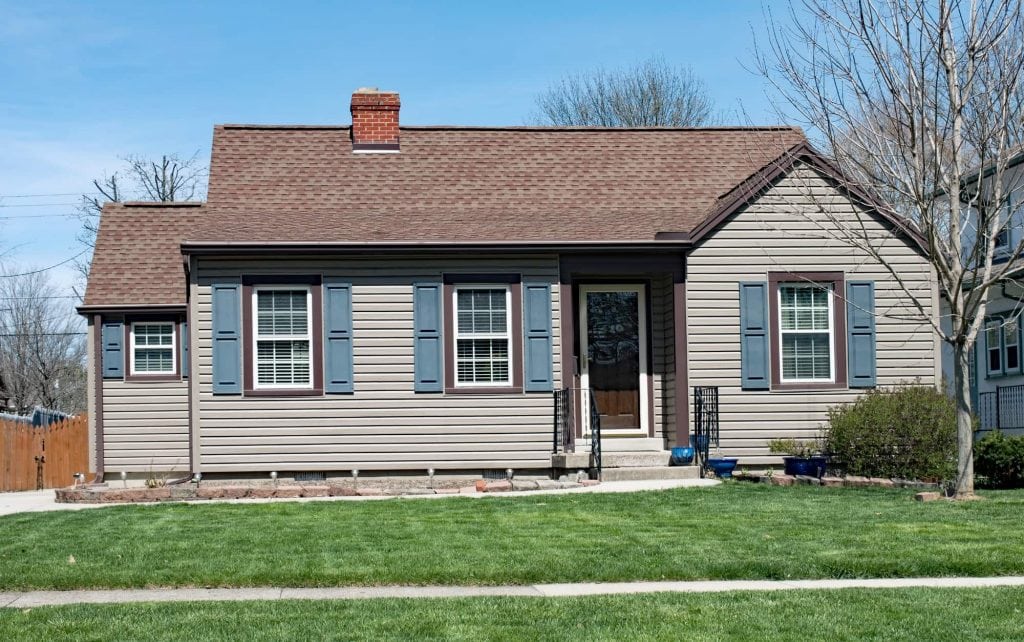
Durability and Longevity
One of the standout features of metal siding is its durability. Metal sidings, especially those with a galvanized finish, can last decades with little to no wear and tear. They’re resilient against extreme weather conditions, whether harsh sunlight, heavy rain, or strong winds. The non-combustible nature of metal also means it doesn’t ignite easily, adding a layer of protection against potential fires.
Low Maintenance
A significant upside to installing metal siding is its low maintenance requirements. Metal stands firm, unlike wood, which might rot, warp, or become prey to termites. It doesn’t harbor mold or rust easily, especially when treated with advanced paint technology.
Energy Efficiency
Metal wall panels have inherent energy-saving properties. Their insulating characteristics help maintain indoor temperatures, reducing the need for heating or cooling systems to work overtime. This conserves energy and translates to significant cost savings in utility bills.
Fire Resistance
Safety is paramount in any construction project, and metal siding scores high in this department. It is non-combustible and doesn’t catch fire easily, offering superior protection against potential fire hazards.
Aesthetic Versatility
With a wide range of colors, from classic brown and chestnut brown to more vibrant hues like leaf green, desert beige, and terra-cotta colonial red, metal siding allows homeowners and builders immense design flexibility.
The range of colors provide abundant options whether you’re aiming for a rustic look with corrugated steel siding or a sleek modern design with flat metal surfaces.
Cons of Metal Siding
While metal siding boasts numerous advantages, it’s essential to consider its limitations.
Initial Cost
Metal siding, especially premium color varieties or those with a galvalume material, can come with a heftier price upfront than other siding options. However, considering its durability and low maintenance, it is often a cost-effective solution in the long run.
Denting and Noise
Certain types of metal siding, particularly those with thinner panel profiles, can be prone to denting. Also, metal can be noisier than other materials during heavy rainfall or hailstorms.
Susceptibility to Scratches and Fading
Over time, especially under harsh weather conditions, metal siding can experience fading. Scratches, if deep enough, reduce its visual appeal.
Installation and Maintenance Tips for Metal Siding
While metal siding offers a range of benefits, from its aesthetic appeal to its durability, getting the most out of it largely depends on its installation and maintenance.
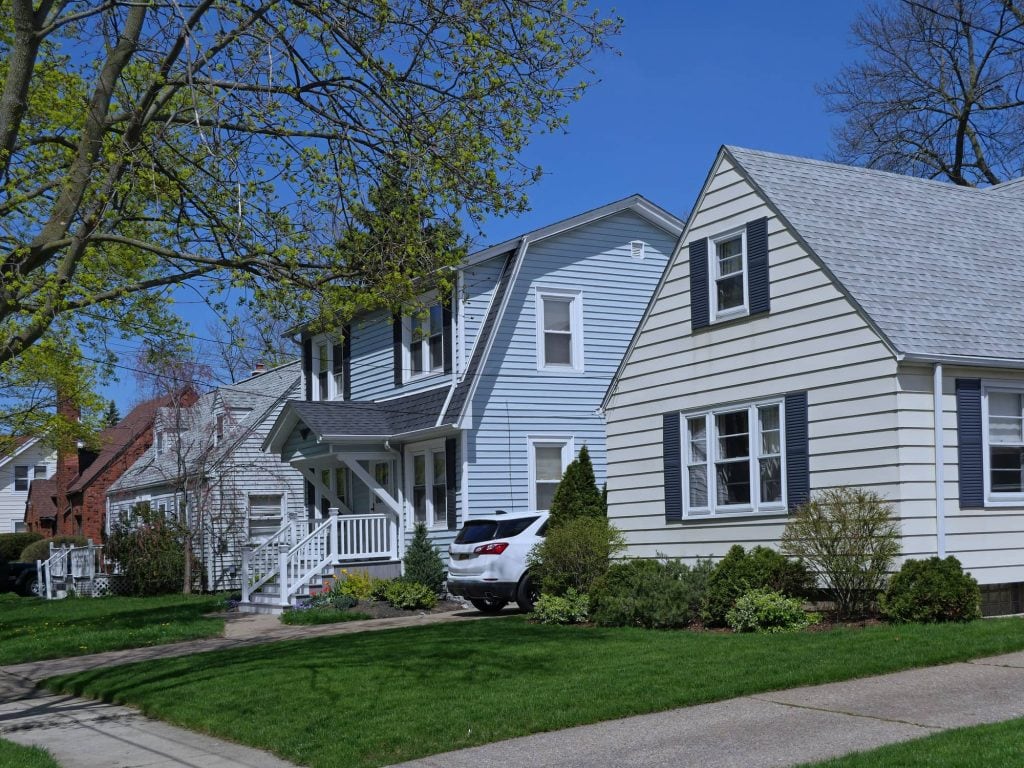
Hiring a Professional vs. DIY Installation
Metal siding installation is more intricate than it appears. The alignment of panels, ensuring proper fastener attachment spacing, and addressing potential performance issues like oil canning requires expertise.
While a wide range of tutorials are available, a DIY approach may lead to errors that affect the siding’s longevity and functionality. A proper installation ensures maximum energy efficiency and optimal performance against extreme weather conditions.
While you may feel the temptation to install it yourself, seeking help from a professional ensures your metal siding serves its purpose effectively.
Regular Cleaning and Maintenance
Keeping your metal siding clean enhances its curb appeal and ensures longevity. Aim to clean your siding at least once a year or more frequently if your building is in an area with high pollution or dust levels.
Periodic inspections for scratches, dents, or any signs of corrosion are essential. Catching these issues early and addressing them can prevent more significant, costlier problems down the road.
Paint and Coating Considerations
Despite the durability of metal, over time, its paint might start to fade or chip. A repainting or recoating every few years helps maintain its fresh look and provides additional protection against corrosion.
When choosing paint or coatings, opt for high-quality products, preferably those with UV protection. This ensures the color remains vibrant and enhances the siding’s lifespan.
Key Takeaways
Metal siding is a durable, aesthetically versatile, and energy-efficient option for buildings. Its pros, such as longevity, low maintenance, and aesthetic appeal, make it a standout choice.
However, considerations like initial cost and potential for dents or noise need to be weighed. Whether you’re eyeing it for its modern design, energy-saving benefits, or its wide range of colors, ensure you’re making an informed decision based on your building’s needs and your personal preferences.
If you’re looking to buy a property with metal siding, whether residential or commercial, make a custom home search and use our filters to search for specific keywords. Need additional assistance? Contact a local eXp agent for expert guidance.
FAQs: Metal Siding
Let’s highlight some of the most commonly asked questions about metal siding.
Is metal siding expensive?
While metal siding can have a higher upfront cost than other materials, its durability and minimal maintenance often make it a cost-effective option in the long run, no matter how many square feet you need to cover.
Is metal siding cheaper than vinyl siding?
Generally, vinyl siding tends to be less expensive initially than metal siding. However, metal might offer better value over time when factoring in longevity and maintenance.
Is metal siding a good idea?
Absolutely! Its durability, energy efficiency, and aesthetic versatility make it a worthy consideration for many building projects.
Is metal siding the same as steel siding?
Not necessarily. While steel is a type of metal, metal siding can be made from various metals, including aluminum and stainless steel.
Does metal siding add value to a home?
Metal siding boosts the value of the home due to factors like durability, modern aesthetic, and energy efficiency.
What is the least expensive siding option?
Vinyl is often considered the most affordable siding option, though prices vary based on quality and brand.
Do you need sheathing under metal siding?
Yes, sheathing provides additional insulation and ensures a flat, even surface for the siding.
Does metal siding make a house hotter?
No, with proper insulation, metal siding can reflect heat, helping to regulate indoor temperatures.
Can you put metal over wood siding?
Yes, metal can be installed over existing wood siding, though ensuring the wood is in good condition is crucial.
How do you attach metal siding to a house?
Metal siding is typically attached using screws, but the specific method can vary based on the type of metal and the manufacturer’s recommendations.
Should I choose vertical or horizontal metal siding?
Both have their merits. Vertical siding often sheds water better and is commonly used for commercial buildings, while horizontal siding offers a more traditional appearance.
Can you put metal siding on plywood?
Yes, metal siding can be installed over plywood, provided the plywood is flat and in good condition.
How often does metal siding need to be replaced?
Proper maintenance means metal siding can last several decades, often outlasting other siding materials.
]]>